Sony Group DCRPC120 Digital Video Camera Recorder - Bluetooth User Manual DCR PC115 PC120BT
Sony Corporation Digital Video Camera Recorder - Bluetooth DCR PC115 PC120BT
Contents
Users Manual I
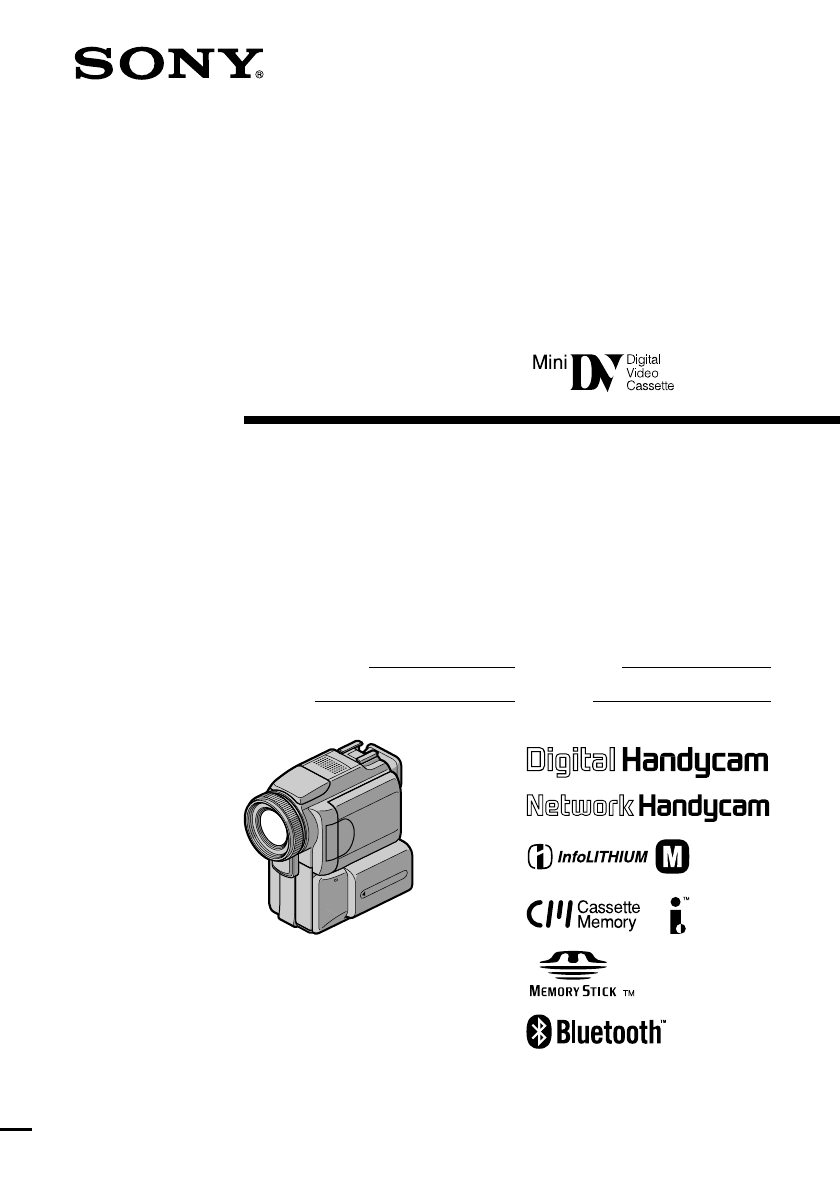
3-070-602-11 (1)
©2001 Sony Corporation
Operating Instructions
Before operating the unit, please read this manual thoroughly,
and retain it for future reference.
Owner’s Record
The model and serial numbers are located on the bottom. Record the
serial number in the space provided below. Refer to these numbers
whenever you call upon your Sony dealer regarding this product.
DCR-PC115/PC120BT
Digital
Video Camera
Recorder
Model No. DCR-PC Model No. AC-
Serial No. Serial No.
SERIES
TM
DCR-PC120BT
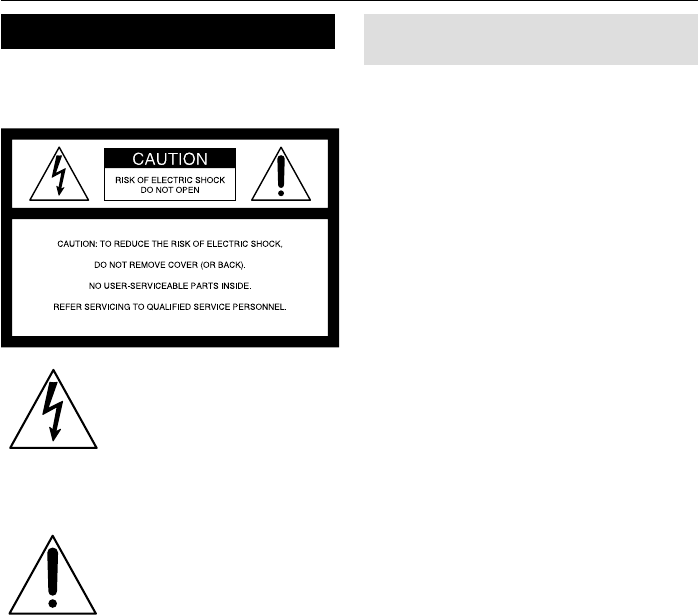
2
Welcome!
Congratulations on your purchase of this Sony Handycam. With your Handycam, you can
capture life’s precious moments with superior picture and sound quality. Your Handycam is
loaded with advanced features, but at the same time it is very easy to use. You will soon be
producing home video that you can enjoy for years to come.
WARNING
To prevent fire or shock hazard, do
not expose the unit to rain or
moisture.
CAUCTION
The use of optical instruments with this
product will increase eye hazard. As the laser
beam used in this Handycam is harmful to
eyes, do not attempt to disassemble the
cabinet.
Refer to servicing to qualified personnel only.
This symbol is intended to
alert the user to the presence
of uninsulated “dangerous
voltage” within the product’s
enclosure that may be of
sufficient magnitude to
constitute a risk of electric
shock to persons.
This symbol is intended to
alert the user to the presence
of important operating and
maintenance (servicing)
instructions in the literature
accompanying the appliance.
For customers in the U.S.A.
and CANADA
CAUTION
TO PREVENT ELECTRIC SHOCK, MATCH
WIDE BLADE OF PLUG TO WIDE SLOT,
FULLY INSERT.
DISPOSAL OF LITHIUM ION BATTERY.
LITHIUM ION BATTERY.
DISPOSE OF PROPERLY.
You can return your unwanted lithium ion
batteries to your nearest Sony Service Center
or Factory Service Center.
Note: In some areas the disposal of lithium
ion batteries in household or business
trash may be prohibited.
For the Sony Service Center nearest you call
1-800-222-SONY (United States only).
For the Sony Factory Service Center nearest
you call 416-499-SONY (Canada only).
Caution: Do not handle damaged or leaking
lithium ion battery.
“Memory Stick”
THIS DEVICE COMPLIES WITH PART 15 OF
THE FCC RULES. OPERATION IS SUBJECT
TO THE FOLLOWING TWO CONDITIONS:
(1) THIS DEVICE MAY NOT CAUSE
HARMFUL INTERFERENCE, AND (2) THIS
DEVICE MUST ACCEPT ANY
INTERFERENCE RECEIVED, INCLUDING
INTERFERENCE THAT MAY CAUSE
UNDESIRED OPERAION.
THIS CLASS B DIGITAL APPARATUS
COMPLIES WITH CANADIAN ICES-003.

3
For the customers in the U.S.A.
If you have any questions about this product,
you may call:
Sony Customer Information Center 1-800-222-
SONY (7669)
The number below is for the FCC related
matters only.
Regulatory Information
Declaration of Conformity
Trade Name: SONY
Model No.: DCR-PC120
Responsible Party: Sony Electronics Inc.
Address: 680 Kinderkamack
Road, Oradell,
NJ07649 U.S.A.
Telephone No.: 201-930-6972
This device complies with Part 15 of the
FCC Rules. Operation is subject to the
following two conditions: (1) This device
may not cause harmful interference, and
(2)this device must accept any interference
received, including interference that may
cause undesired operation.
CAUTION
You are cautioned that any changes or
modifications not expressly approved in this
manual could void your authority to operate
this equipment.
Note:
This equipment has been tested and found to
comply with the limits for a Class B digital
device, pursuant to Part 15 of the FCC Rules.
These limits are designed to provide
reasonable protection against harmful
interference in a residential installation. This
equipment generates, uses, and can radiate
radio frequency energy and, if not installed
and used in accordance with the instructions,
may cause harmful interference to radio
communications. However, there is no
guarantee that interference will not occur in a
particular installation. If this equipment does
cause harmful interference to radio or
television reception, which can be determined
by turning the equipment off and on, the user
is encouraged to try to correct the interference
by one or more of the following measures:
— Reorient or relocate the receiving antenna.
— Increase the separation between the
equipment and receiver.
— Connect the equipment into an outlet on a
circuit different from that to which the
receiver is connected.
— Consult the dealer or an experienced
radio/TV technician for help.
The supplied interface cable must be used with
the equipment in order to comply with the
limits for a digital device pursuant to Subpart
B of Part 15 of FCC Rules.
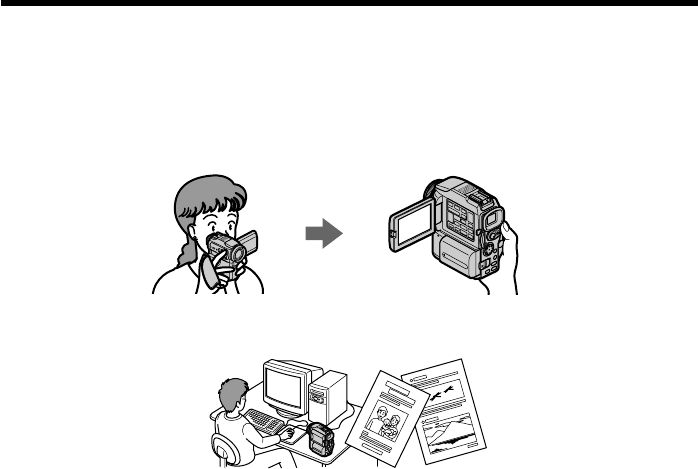
4
Taking moving or still images, and playing them back
•Recording a moving picture on a tape (p. xx)
•Recording a still image on a tape (p. xx)
•Playing back a tape (p. xx)
•Recording still images on “Memory Stick”s (p. xx)
•Recording moving pictures on “Memory Stick”s (p. xx)
•Viewing a still image recorded on “Memory Stick”s (p. xx)
•Viewing a moving picture on “Memory Stick”s (p. xx)
Capturing images on your computer
•Using with an analog video unit and your computer (p. xx)
•Viewing images recorded on “Memory Stick”s using the USB cable (p. xx)
Accessing to the Internet via a Bluetooth equipped device
(DCR-PC120BT only)
Accessing the Internet, sending/receiving your e-mail, and using the album on the Web
(Only in North America and Japan). For details, refer to the Network Operating
Instructions supplied with your camcorder. (p. xx)
Other uses
Functions to adjust exposure in the recording mode
•Back light (p. xx)
•NightShot/Super NightShot (p. xx)
•Recording images with the flash (p. xx, xx)
•PROGRAM AE (p. xx)
•Adjusting the exposure manually (p. xx)
Functions to give images more impact
•Digital zoom (p. xx) The default setting is set to OFF. (To zoom greater than 10×, select
the digital zoom power in D ZOOM in the menu settings.)
•Fader (p. xx)
•Picture effect (p. xx)
•Digital effect (p. xx)
•Title (p. xx, xx)
•MEMORY MIX (p. xx)
Functions to give a natural appearance to your recordings
•Sports lesson (p. xx)
•Landscape (p. xx)
•Manual focus (p. xx )
Functions to use on recorded tapes
•END SEARCH/EDITSEARCH/Rec Review (p. xx)
•DATA CODE (p. xx)
•Tape PB ZOOM (p. xx)
•Zero set memory (p. xx, xx)
•Title search (p. xx)
•Digital program editing (p. xx, xx)
•HiFi SOUND (p. xx)
Main Features
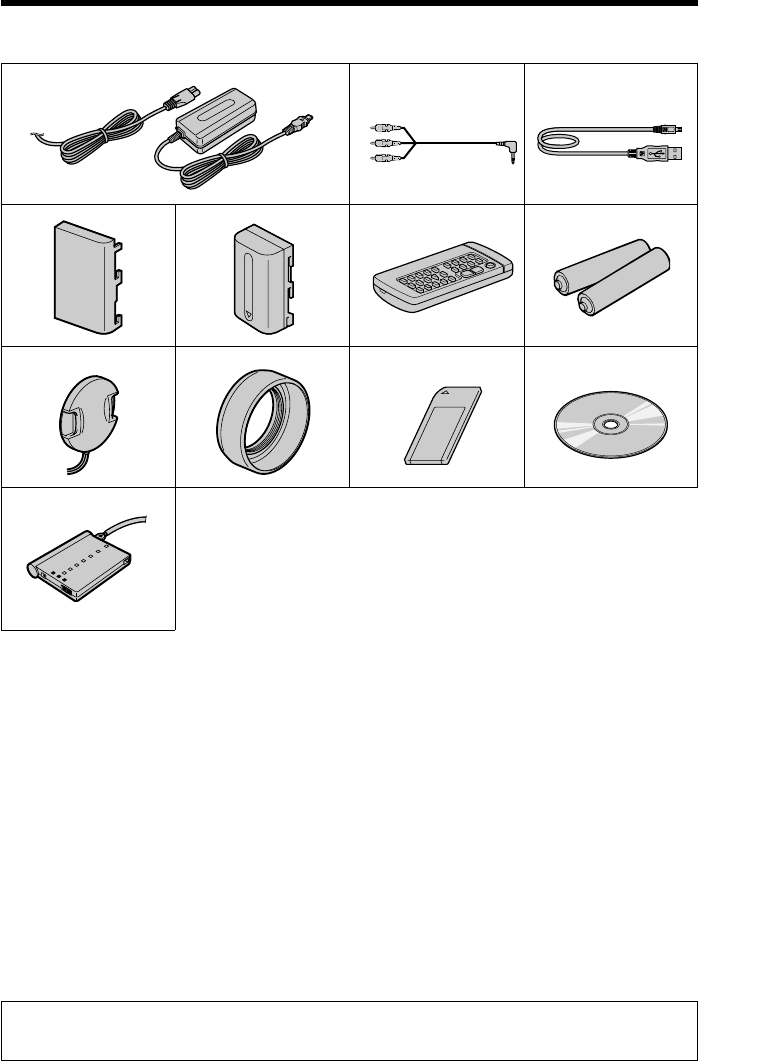
Getting started
5
Checking supplied accessories
Make sure that the following accessories are supplied with your camcorder.
1AC-L10A/L10B/L10C AC power
adaptor (1), Power cord (1) (p. xx)
2A/V connecting cable (1) (p. xx, xx)
3USB cable (1) (p. xx)
4Battery terminal cover (1) (p. xx)
5NP-FM50 battery pack (1) (p. xx, xx)
6Wireless Remote Commander (1)
(p. xx)
7Size AA (R6) battery for Remote
Commander (2) (p. xx)
8Lens cap (1) (p. xx)
Contents of the recording cannot be compensated if recording or playback is not made due to a
malfunction of the camcorder, storage media, etc.
8
12
7
9q;
45
qa
3
6
qs
9Lens hood (1) (p. xx)
q; “Memory Stick” (1) (p. xx)
qa CD-ROM (SPVD-004 USB Driver) (1)
(p. xx)
qs Bluetooth adaptor (BTA-NW1) * (1)
(p. xx)
qd Bluetooth modem cord (MDM-
5614G)*(1) (p.xx)
qf Bluetooth modem cable*(1) (p.xx)
qg AC power adapter (AC-PT1)*(1) (p.xx)
qh Alkarine AA dry batteries for
Bluetooth Adaptor*(2) (p.xx)
*DCR-PC120BT only

6
Table of contents
Main Features .......................................... 4
Checking supplied accessories.............. 5
Quick Start Guide........................8
Getting started
Using this manual ................................. 10
Step 1 Preparing the power supply... 12
Installing the battery pack............. 12
Charging the battery pack............. 13
Step 2 Setting the date and time ........ 16
Step 3 Inserting a cassette ................... 18
Recording – Basics
Recording a picture............................... 19
Shooting backlit subjects
– BACK LIGHT ........................ 26
Shooting in the dark – NightShot/
Super NightShot ...................... 26
Self-timer recording ....................... 28
Checking the recording
– END SEARCH / EDITSEARCH /
Rec Review ...................................... 29
Playback – Basics
Playing back a tape ............................... 30
To display the screen indicators
– Display function ................... 31
Viewing the recording on TV.............. 34
Advanced Recording
Operations
Recording a still image on a tape
– Tape Photo recording ................. 35
Adjusting the white balance
manually .......................................... 39
Using the wide mode ........................... 40
Using the fader function ...................... 41
Using special effects – Picture effect .. 44
Using special effects – Digital effect... 45
Using the PROGRAM AE function .... 48
Adjusting the exposure manually ...... 51
Focusing manually................................ 52
Interval recording ................................. 54
Frame by frame recording
– Cut recording ............................... 56
Advanced Playback
Operations
Playing back a tape with picture effects
........................................................... 57
Playing back a tape with digital effects
........................................................... 58
Enlarging images recorded on tapes
– Tape PB ZOOM ........................... 59
Quickly locating a scene using the zero
set memory function ...................... 60
Searching the boundaries of recorded
tape by title – Title search ............. 61
Searching a recording by date
– Date search ................................... 62
Searching for a photo
– Photo search/Photo scan ........... 64
Editing
Dubbing a tape ...................................... 66
Dubbing only desired scenes
– Digital program editing
(to a tape) ......................................... 68
Using with analog video unit and your
computer
– Signal convert function
........................................................... 79
Recording video or TV programs ....... 80
Inserting a scene from a VCR
– Insert editing ................................ 83
Audio dubbing ...................................... 85
Superimposing a title ........................... 89
Making your own titles ........................ 92
Labeling a cassette ................................ 93
Customizing Your Camcorder
Changing the menu settings................ 95
“Memory Stick” Operations
Using a “Memory Stick”
– introduction................................ 103
Recording still images on “Memory
Stick”s
– Memory Photo recording ......... 111
Recording an image from a tape as a
still image ...................................... 117
Superimposing a still image in the
“Memory Stick” on an image
– MEMORY MIX .......................... 120

Getting started
7
Table of contents
Recording moving pictures on
“Memory Stick”s
– MPEG movie recording............ 125
Recording a picture from a tape as a
moving picture ............................. 127
Recording edited pictures as a moving
picture – Digital program editing
(to a “Memory Stick”).................. 131
Copying still images from a tape
– Photo save .................................. 134
Viewing a still image
– Memory photo playback .......... 135
Viewing a moving picture
– MPEG movie playback ............. 138
Viewing images using computer ...... 140
Copying the image recorded on
“Memory Stick”s to tapes ........... 146
Enlarging still images recorded on
“Memory Stick”s
– Memory PB ZOOM ................... 147
Playing back images in a continuous
loop – SLIDE SHOW.................... 148
Preventing accidental erasure
– Image protection........................ 149
Deleting images................................... 150
Writing a print mark
– PRINT MARK ............................ 152
Using the optional printer ................. 153
Using the Network function
Accessing to the network................... 154
Troubleshooting
Types of trouble and their solutions
......................................................... 155
Self-diagnosis display......................... 161
Warning indicators and messages.... 162
Additional Information
Usable cassettes ................................... 164
About the “InfoLITHIUM” battery
pack ................................................ 166
About i.LINK ....................................... 168
Using your camcorder abroad .......... 170
Maintenance information and
precautions .................................... 171
Specifications ....................................... 176
Quick Reference
Identifying the parts and controls .... 178
Index ..................................................... 186
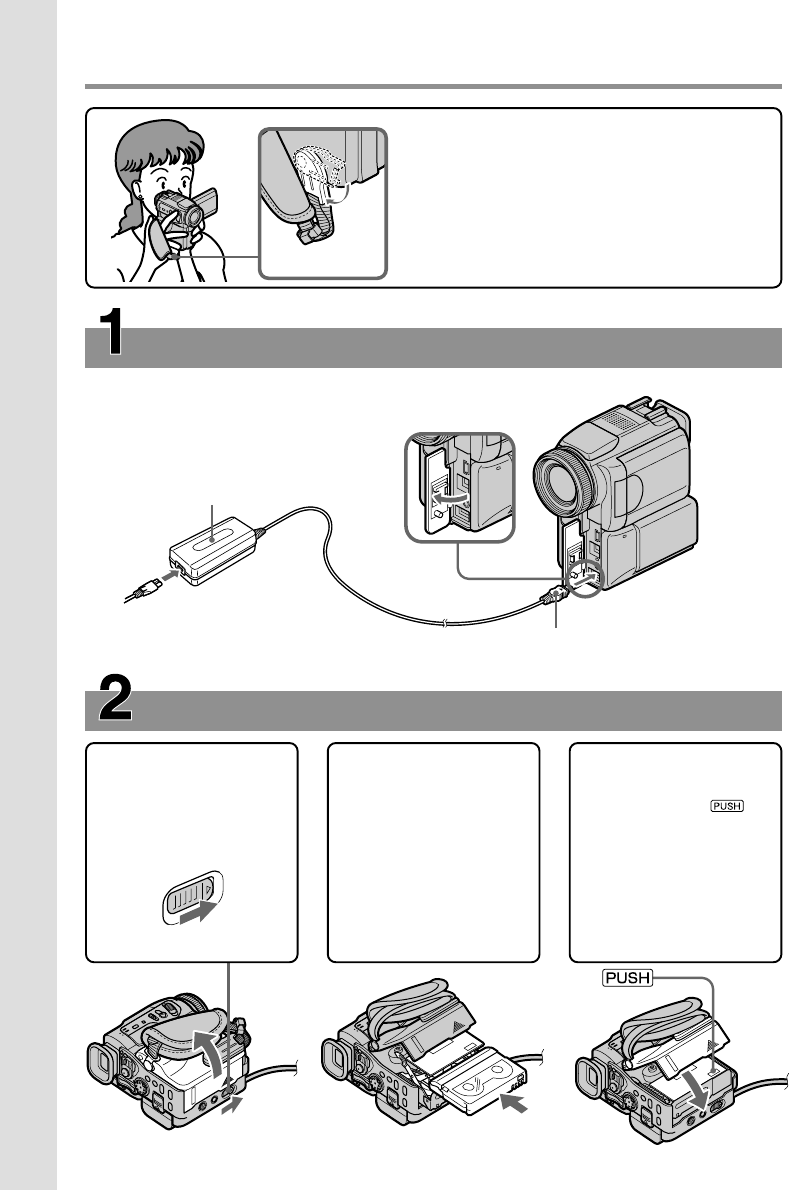
Quick Start Guide
8
Quick Start Guide
Inserting a cassette (p. xx)
Connecting the power cord (p. xx)
Use the battery pack when using your camcorder outdoors (p. xx).
1Slide OPEN/
Z EJECT in the
direction of the
arrow and open the
lid.
2Push the middle
portion of the back
of the cassette to
insert. Insert the
cassette in a straight
line deeply into the
cassette
compartment with
the window facing
out.
3Close the cassette
compartment by
pressing the
mark on the cassette
compartment.
After the cassette
compartment goes
down completely,
close the lid until it
clicks.
This chapter introduces you to the basic features
of your camcorder. See the page in parentheses
“( )” for more information.
Pull down the Holding Grip to hold your
camcorder as illustrated.
AC power adaptor (supplied)
Connect the plug with its v
mark facing up.
Open the jack
cover.
Holding Grip
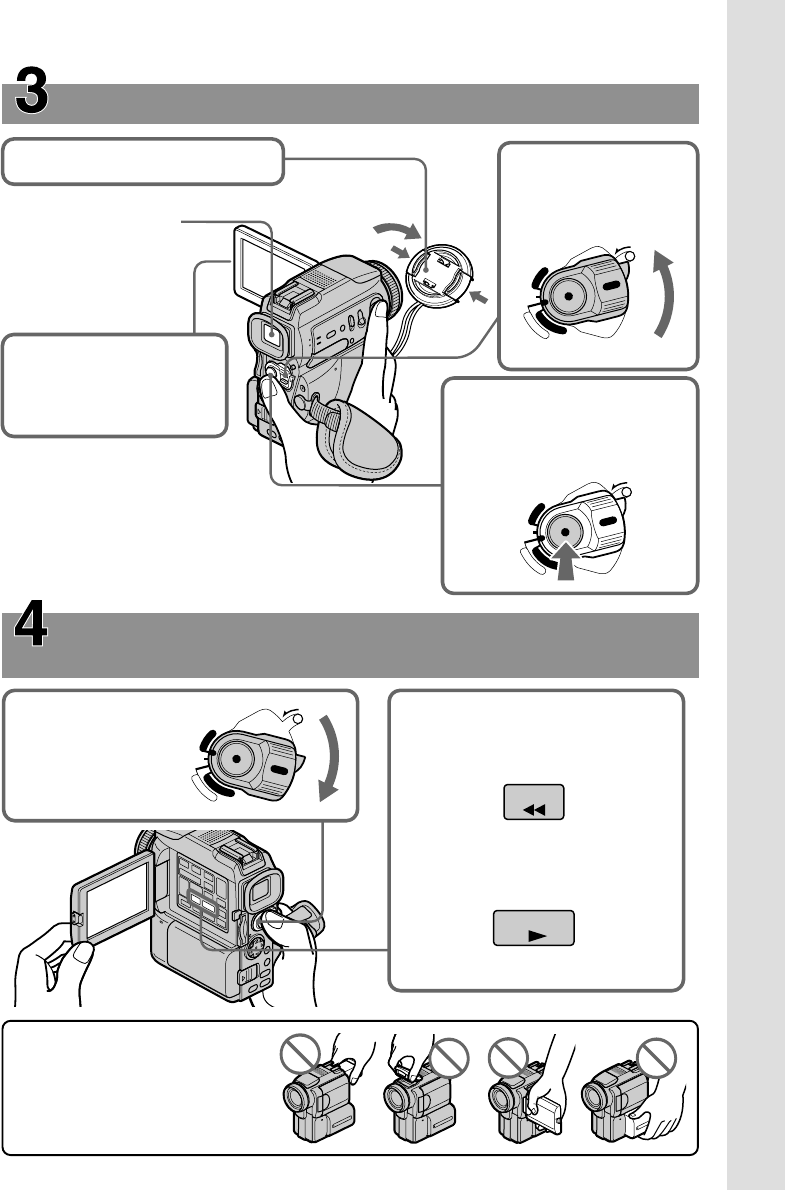
Quick Start Guide
9
LOCK
POWER
V
C
R
M
E
M
O
R
Y
C
A
M
E
R
A
OFF
(CHG)
LOCK
POWER
V
C
R
M
E
M
O
R
Y
C
A
M
E
R
A
OFF
(CHG)
Recording a picture (p. xx)
1Remove the lens cap.
3Press OPEN to open the
LCD panel.
The picture appears on
the screen.
2Set the POWER
switch to CAMERA
while pressing the
small green button.
4Press START/STOP. Your
camcorder starts recording.
To stop recording, press
START/STOP again.
Monitoring the playback picture on the LCD
screen (p. xx)
NOTE
Do not pick up your camcorder by
holding the viewfinder, the flash, the
LCD panel or the battery pack.
When you purchase your camcorder, the clock setting
is set to off. If you want to record the date and time for
a picture, set the clock setting before recording (p. xx).
PLAY
REW
LOCK
POWER
V
C
R
M
E
M
O
R
Y
C
A
M
E
R
A
OFF
(CHG)
1Set the POWER
switch to VCR
while pressing the
small green button.
2Press m to rewind the tape.
3Press N to start playback.
Viewing a picture with
the viewfinder
Close the LCD panel,
and pull out the
viewfinder.
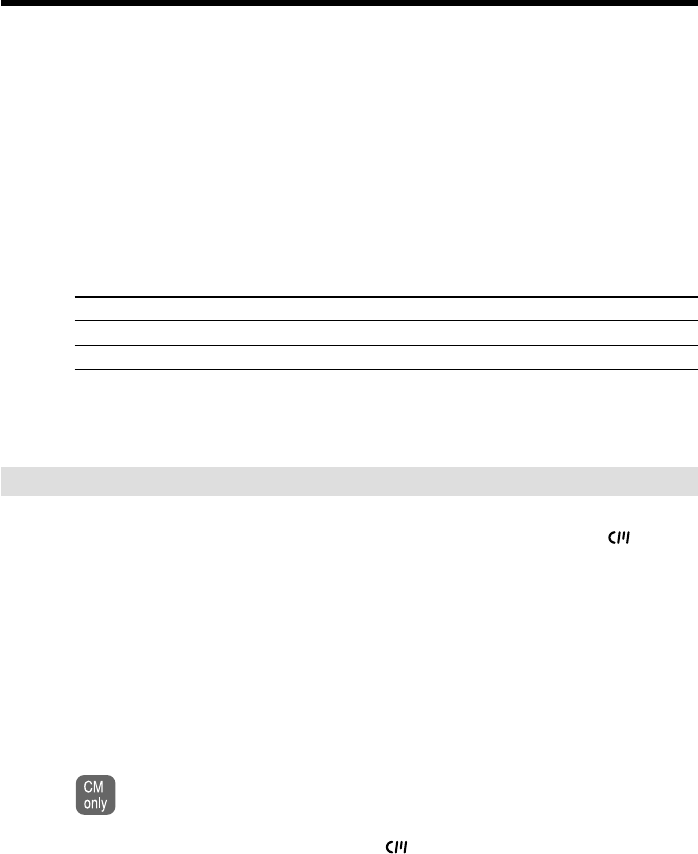
10
— Getting started —
Using this manual
The instructions in this manual are for the two models listed in the table below. Before
you start reading this manual and operating your camcorder, check the model number
by looking at the bottom of your camcorder. (DCR-PC120BT is marked as DCR-PC120
on the bottom of this unit.) The DCR-PC120BT is the model used for illustration
purposes. Otherwise, the model name is indicated in the illustrations. Any differences
in operation are clearly indicated in the text, for example, “DCR-PC120BT only”.
As you read through this manual, buttons and settings on your camcorder are shown in
capital letters.
e.g. Set the POWER switch to CAMERA.
When you carry out an operation, you can hear a beep sound to indicate that the
operation is being carried out.
Types of differences
DCR- PC115 PC120BT
Bluetooth adaptor — z
Network — z
zProvided
— Not provided
Note on Cassette Memory
Your camcorder is based on the DV format. You can only use mini DV cassettes with
your camcorder. We recommend that you use a tape with cassette memory .
The functions which require different operations depending on whether the tape has
the cassette memory or not are:
– End search (p. xx)
– Date search (p. xx)
– Photo search (p. xx)
The functions you can operate only with the cassette memory are:
– Title search (p. xx)
– Superimposing a title (p. xx)
– Labeling a cassette (p. xx)
For details, see page xx.
You see this mark in the introduction of the features that are operated only with
cassette memory.
Tapes with cassette memory are marked by (Cassette Memory).
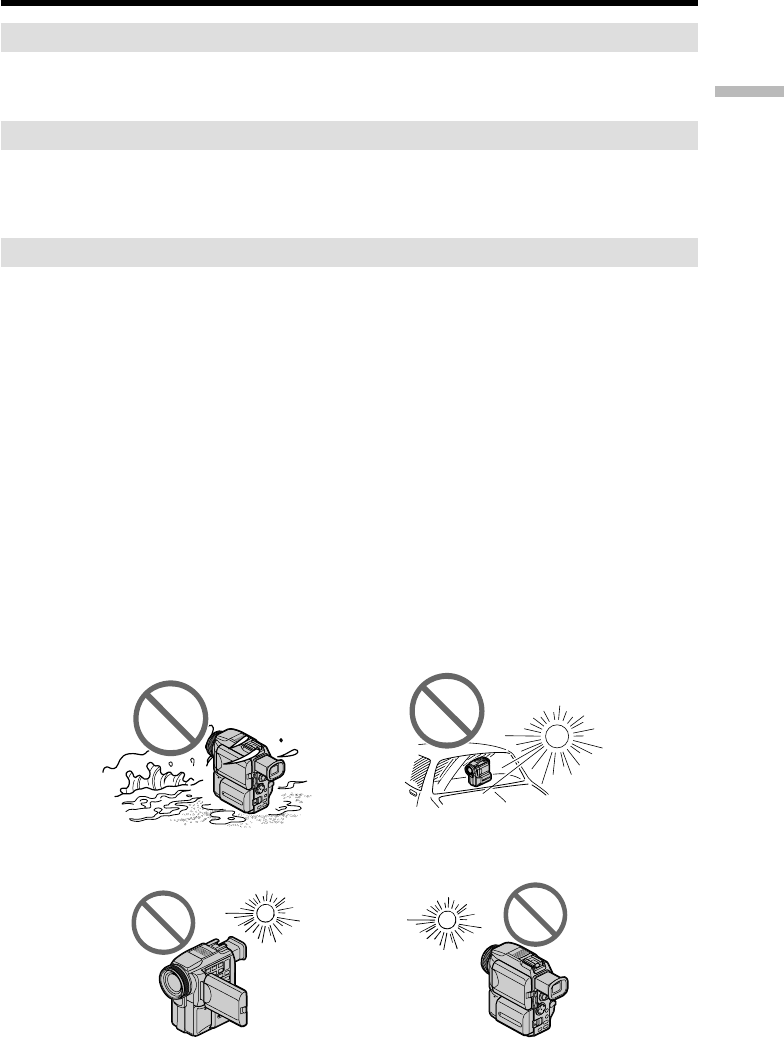
Getting started
11
Using this manual
Note on TV color systems
TV color systems differ from country to country. To view your recordings on a TV, you
need an NTSC system-based TV.
Copyright precautions
Television programs, films, video tapes, and other materials may be copyrighted.
Unauthorized recording of such materials may be contrary to the provision of the
copyright laws.
Precautions on camcorder care
Lens and LCD screen/finder (on mounted models only)
•The LCD screen and the finder are manufactured using extremely high-precision
technology, so over 99.99% of the pixels are operational for effective use.
However, there may be some tiny black points and/or bright points (white, red,
blue or green in color) that constantly appear on the LCD screen and the finder.
These points are normal in the manufacturing process and do not affect the
recording in any way.
•Do not let your camcorder get wet. Keep your camcorder away from rain and sea
water. Letting your camcorder get wet may cause your camcorder to malfunction.
Sometimes this malfunction cannot be repaired [a].
•Never leave your camcorder exposed to temperatures above 60°C (140°F), such as in a
car parked in the sun or under direct sunlight [b].
•Be careful when placing the camera near a window or outdoors. Exposing the LCD
screen, the finder or the lens to direct sunlight for long periods may cause
malfunctions [c].
•Do not directly shoot the sun. Doing so might cause your camcorder to malfunction.
Take pictures of the sun in low light conditions such as dusk [d].
[a][b]
[c][d]
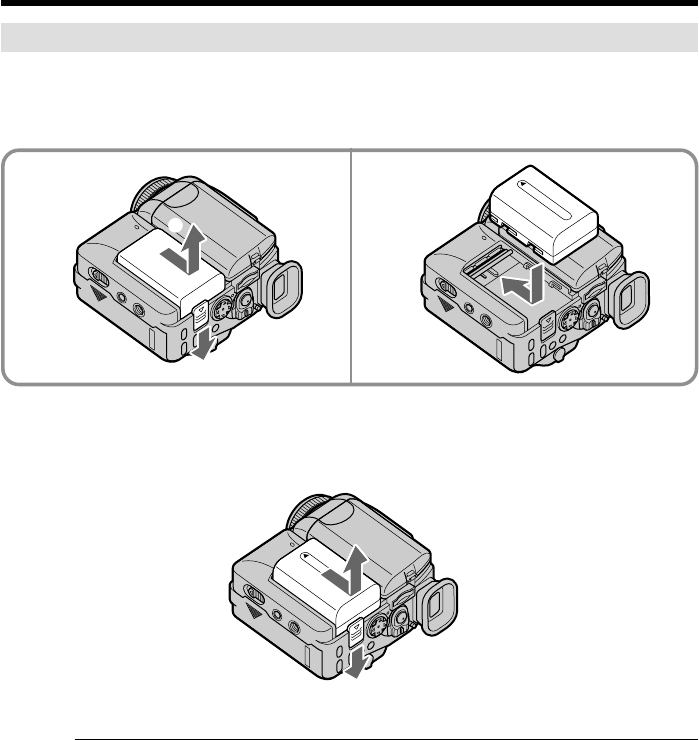
12
Installing the battery pack
(1)While sliding BATT RELEASE in the direction of the arrow 1, slide the
battery terminal cover in the direction of the arrow 2.
(2)Insert the battery pack in the direction of the arrow until it clicks.
To remove the battery pack
The battery pack is removed in the same way as the battery terminal cover.
Note on the battery terminal cover
To protect the battery terminals, install the battery terminal cover after the battery pack
is removed.
Step 1 Preparing the power supply
1 2
2
1
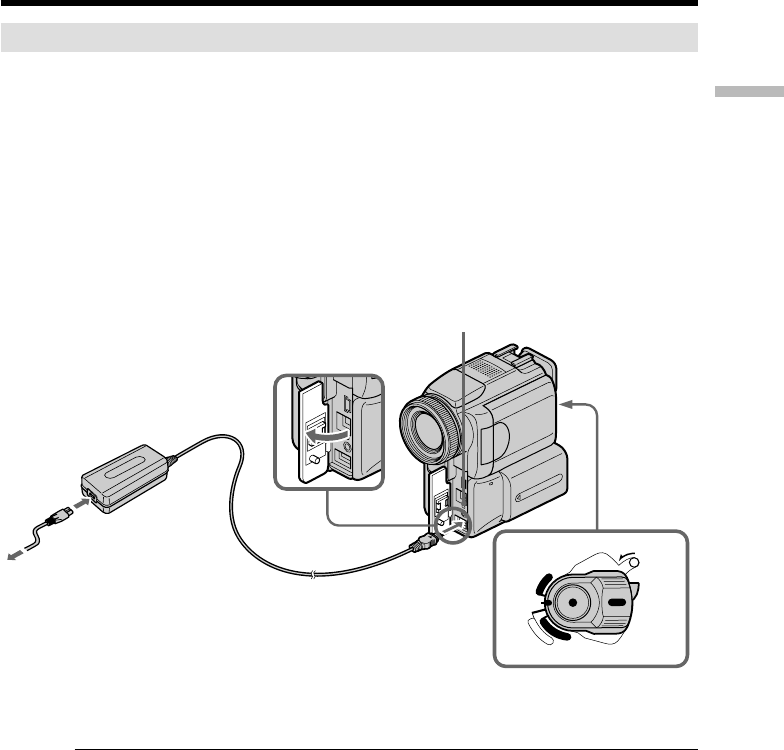
13
Getting started
Charging the battery pack
Use the battery pack after charging it for your camcorder.
Your camcorder operates only with the “InfoLITHIUM” battery pack (M series).
See page xxx for details of “InfoLITHIUM” battery pack.
(1)Open the jack cover and connect the AC power adaptor supplied with your
camcorder to the DC IN jack with the plug’s v mark facing up.
(2)Connect the power cord to the AC power adaptor.
(3)Connect the power cord to the wall outlet.
(4)Set the POWER switch to OFF (CHG). The CHG lamp lights up when the
charge begins. After the charge is completed, the CHG lamp goes out. (full
charge)
After charging the battery pack
Disconnect the AC power adaptor from the DC IN jack on your camcorder.
Note
Prevent metallic objects from coming into contact with the metal parts of the DC plug of
the AC power adaptor. This may cause a short-circuit, damaging the AC power
adaptor.
While charging the battery pack, the CHG lamp flashes in the following cases:
–The battery pack is not installed correctly.
–Something is wrong with the battery pack.
When you use the AC power adaptor
Place the AC power adaptor near a wall outlet. If any trouble occurs with this unit,
disconnect the plug from a wall outlet as soon as possible to cut off the power.
Step 1 Preparing the power supply
4
2
1
LOCK
POWER
V
C
R
M
E
M
O
R
Y
C
A
M
E
R
A
OFF
(CHG)
CHG lamp

14
Step 1 Preparing the power supply
Charging time
Battery pack Full charge
NP-FM50 (supplied) 150
NP-FM70 240
NP-FM90 330
NP-FM91 360
The charging time may increase if the battery’s temperature is extremely high or low
because of the ambient temperature.
Approximate minutes at 25°C (77°F) to charge an empty battery pack
Recording time
Recording with Recording with
Battery pack the viewfinder the LCD screen
Continuous* Typical** Continuous* Typical**
NP-FM50 (supplied) 130 75 110 60
NP-FM70 270 155 230 130
NP-FM90 410 235 355 205
NP-FM91 475 275 410 235
Approximate minutes when you use a fully charged battery
*Approximate continuous recording time at 25°C (77°F). The battery life will be
shorter if you use your camcorder in a cold environment.
**Approximate number of minutes when recording while you repeat recording start/
stop, zooming and turning the power on/off. The actual battery life may be shorter.
Playing time
Battery pack Playing time Playing time
on LCD screen with LCD closed
NP-FM50 (supplied) 150 185
NP-FM70 310 385
NP-FM90 475 580
NP-FM91 550 670
Approximate minutes when you use a fully charged battery
Approximate continuous playing time at 25°C (77°F). The battery life will be shorter if
you use your camcorder in a cold environment.
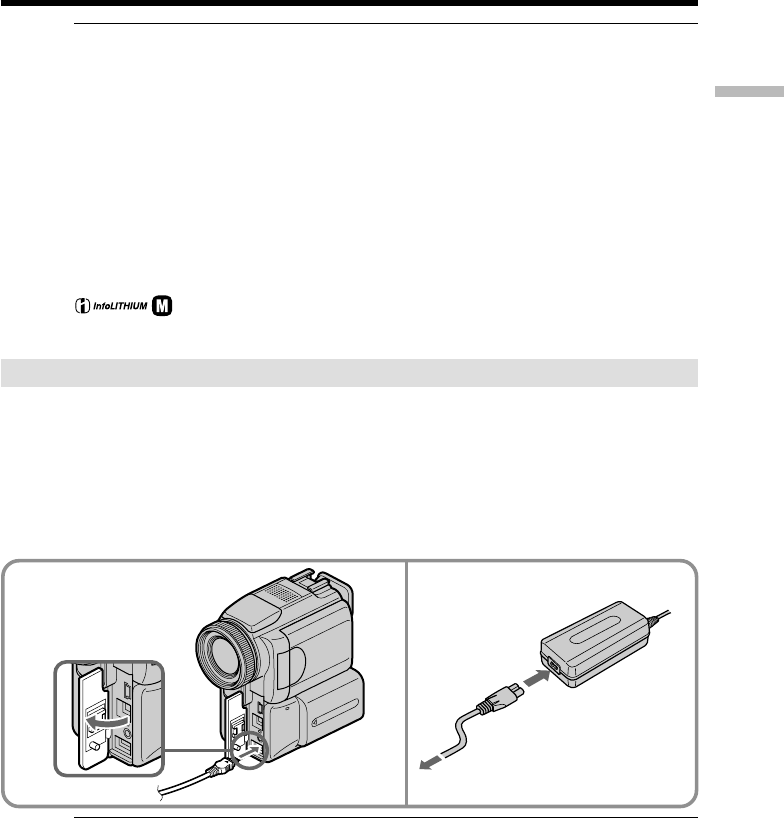
15
Getting started
If the power goes off although the battery remaining indicator indicates that the
battery pack has enough power to operate
Charge the battery pack fully again so that the indication on the battery remaining
indicator is correct.
Recommended charging temperature
We recommend charging the battery pack in an ambient temperature of between 10°C
to 30°C (50°F to 86°F).
What is ”InfoLITHIUM”?
The “InfoLITHIUM” is a lithium ion battery pack which can exchange data such as
battery consumption with compatible electronic equipment. This unit is compatible
with the “InfoLITHIUM” battery pack (M series). Your camcorder operates only with
the “InfoLITHIUM” battery. “InfoLITHIUM” M series battery packs have the
SERIES
TM
mark.
“InfoLITHIUM” is a trademark of Sony Corporation.
Connecting to a wall outlet
When you use your camcorder for a long time, we recommend that you power it from a
wall outlet using the AC power adaptor.
(1)Open the jack cover. Connect the AC power adaptor supplied with your
camcorder to the DC IN jack on your camcorder with the plug’s v mark facing
up.
(2)Connect the power cord to the AC power adaptor.
(3)Connect the power cord to a wall outlet.
PRECAUTION
The set is not disconnected from the AC power source (house current) as long as it is
connected to the wall outlet, even if the set itself has been turned off.
Notes
•The AC power adaptor can supply power even if the battery pack is attached to your
camcorder.
•The DC IN jack has “source priority.” This means that the battery pack cannot supply
any power if the power cord is connected to the DC IN jack, even when the power
cord is not plugged into a wall outlet.
Using a car battery
Use Sony DC Adaptor/Charger (optional).
Refer to the operating instructions of the DC Adaptor/Charger for further information.
Step 1 Preparing the power supply
2,3
1
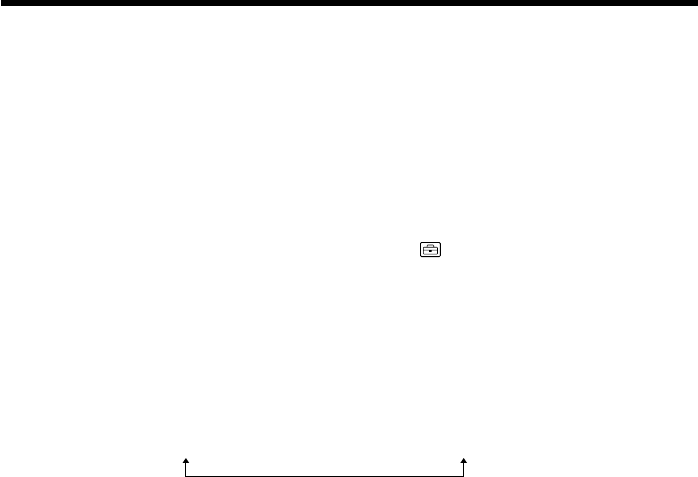
16
Set the date and time settings when you use your camcorder for the first time. “CLOCK
SET” will be displayed each time that you set the POWER switch to CAMERA or
MEMORY unless you set the date and time settings.
If you do not use your camcorder for about three months, the date and time settings
may be released (bars may appear) because the built-in rechargeable battery installed in
your camcorder will have been discharged (p. xx).
Set the area, the summer time, year, month, day, hour and then the minute, in that
order.
(1)Set the POWER switch to CAMERA or MEMORY, then press MENU to display
the menu settings.
(2)Press v/V on the control button to select , then press z or B.
(3)Press v/V on the control button to select CLOCK SET, then press zor B.
(4)Press v/V on the control button to adjust the desired area (where you are),
then press z.
(5)Press v/V on the control button to select whether or not the time is summer
time, then press z.
Select NO if the time is not summer time. Select YES if it is.
(6)Press v/V on the control button to adjust the desired year, then press z.
The year changes as follows:
(7)Set the month, day and hour by pressing v/V on the control button and
pressing z.
(8)Set the minute by pressing v/V on the control button and pressing z by the
time signal. The clock starts to move.
(9)Press MENU to make the menu settings disappear.
Step 2 Setting the date and time
1995 T · · · · t 2001 T · · · · t 2079
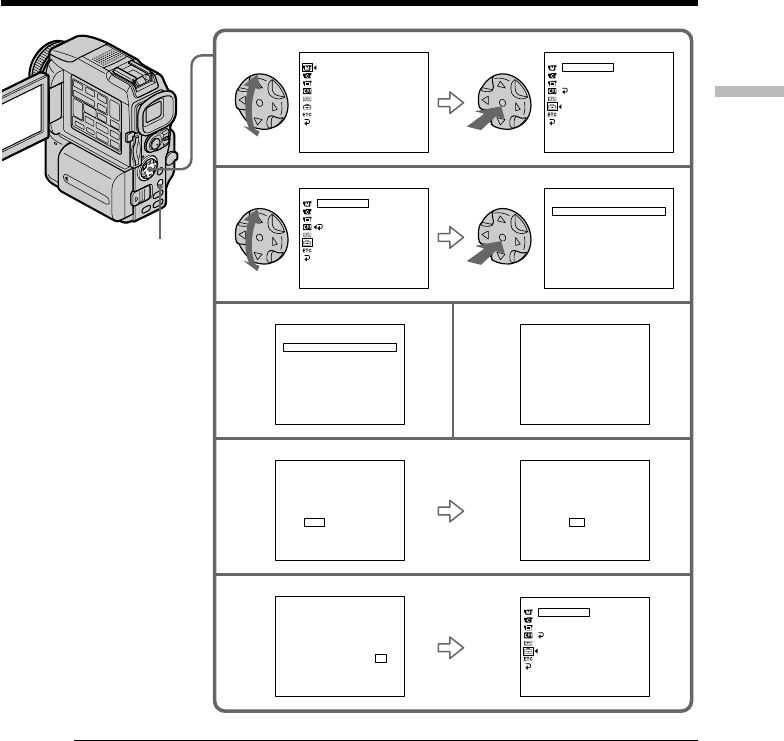
17
Getting started
If you do not set the date and time
“--:--:--” and “--- -- ----” are recorded on the data code of the tape and the “Memory
Stick.”
When using your camcorder abroad
Set the clock to the local time (p. xx).
Note on the time indicator
The internal clock of your camcorder operates on a 12-hour cycle.
•12:00 AM stands for midnight.
•12:00 PM stands for noon.
Step 2 Setting the date and time
2
3
45
6
8
SETUP MENU
CLOCK SET
LTR S IZE ––
:
–
–:––
DEMO MODE
RETURN
[
MENU
] :
END
SETUP MENU
CLOCK SET
LTR S IZE JUL
4 2001
5:30:00
PM
DEMO MODE
RETURN
[
MENU
] :
END
SETUP MENU
CLOCK SET ––
:
–
–:––
LTR S IZE
DEMO MODE
RETURN
[
MENU
] :
END
MANUA L SE T
PROGRAM AE
PEFFECT
DEFFECT
W
HT BAL
AUTO SHTR
[
MENU
] :
END
CLOCK SET
[
EXEC
] :
NEXT I TEM
––––––– –– ––
:
––
DATE Y M D
SUMMERT I ME OFF
r
L i sbon , London
AREA
1
RGMT +
0.0
[
EXEC
] :
NEXT I TEM
––––––– –– ––
:
––
DATE Y M D
SUMMERT I ME OFF
r
NewYo r k , Bo go t a
AREA
14
RGMT +
9.0
[
EXEC
] :
NEXT I TEM
––––––– –– ––
:
––
DATE Y M D
SUMMERT I ME OFF
NewYo r k , Bo go t a
AREA
14
GMT +
9.0
[
EXEC
] :
NEXT I TEM
rrrrr
2001
JAN
112
:00
AM
DATE Y RMRDRRR
SUMMERT I ME OFF
r
NewYo r k , Bo go t a
AREA
14
RGMT +
9.0
[
EXEC
] :
NEXT I TEM
rrrrr
2001
JAN
112
:00
AM
DATE Y RMRDRRR
ON
SUMMERT I ME OFF
NewYo r k , Bo go t a
AREA
14
GMT +
9.0
CLOCK SET
[
EXEC
] :
NEXT I TEM
rrrrr
2001
JUL
45
:30
PM
DATE Y RMRDRRR
SUMMERT I ME OFF
r
NewYo r k , Bo go t a
AREA
14
RGMT +
9.0
CLOCK SET
CLOCK SET
CLOCK SET CLOCK SET
MENU
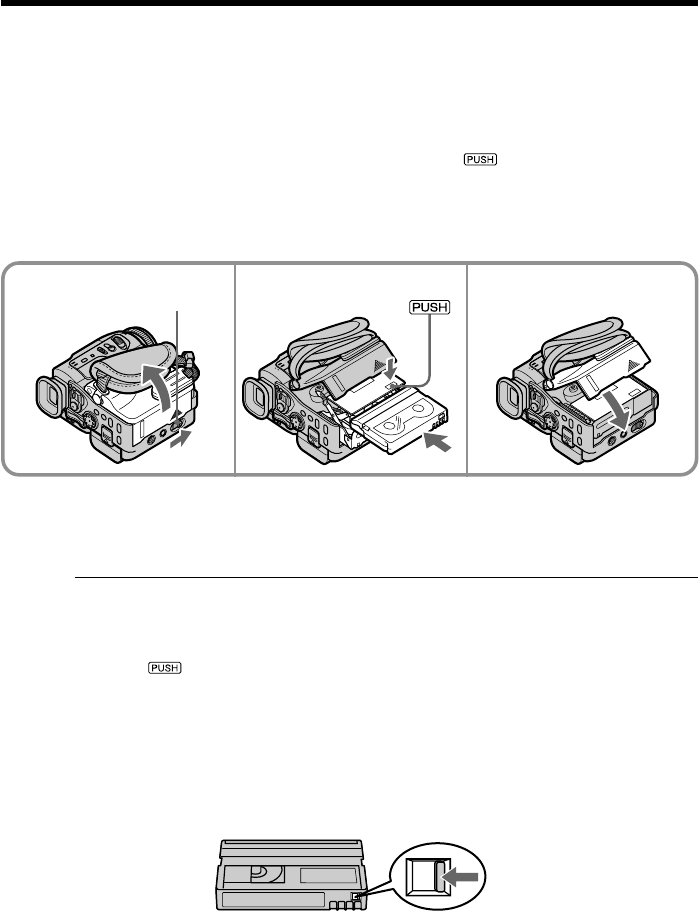
18
(1)Install the power source.
(2)Slide OPEN/Z EJECT in the direction of the arrow and open the lid.
The cassette compartment automatically lifts up and opens.
(3)Push the middle portion of the back of the cassette to insert.
Insert the cassette in a straight line deeply into the cassette compartment with
the window facing out.
(4)Close the cassette compartment by pressing the mark on the cassette
compartment. The cassette compartment automatically goes down.
(5)After the cassette compartment goes down completely, close the lid until it
clicks.
To eject a cassette
Follow the procedure above, and take out the cassette in step 3.
Notes
•Do not press the cassette compartment down forcibly. Doing so may cause a
malfunction.
•The cassette compartment may not be closed when you press any part of the lid other
than the mark.
When you use cassette with cassette memory
Read the instruction about cassette memory to use this function properly (p. xx).
To prevent accidental erasure
Slide the write-protect tab on the cassette to expose the red mark.
Step 3 Inserting a cassette
3, 4 5
2OPEN/Z EJECT
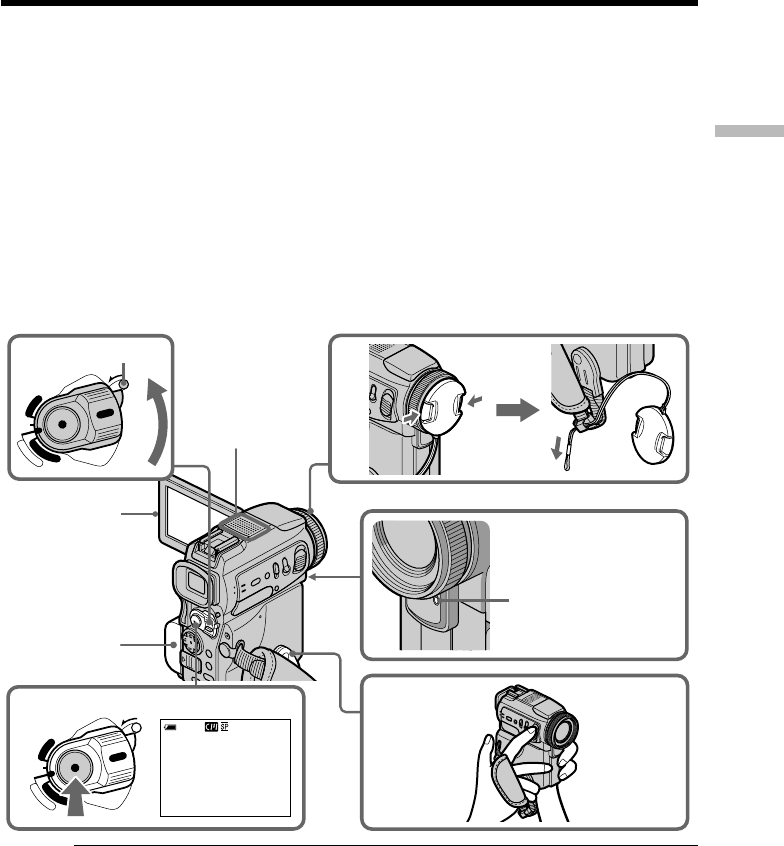
19
Recording – Basics
Your camcorder automatically focuses for you.
(1)Remove the lens cap by pressing both knobs on its sides and pull the lens cap
string to fix it.
(2)Install the power source and insert a cassette. See “Step 1” to “Step 3” for more
information (p. xx to xx).
(3)Pull down the Holding Grip.
Hold your camcorder firmly as illustrated.
(4)Set the POWER switch to CAMERA while pressing the small green button.
Your camcorder is set to the standby mode.
(5)Press OPEN to open the LCD panel. The viewfinder automatically turns off.
(6)Press START/STOP. Your camcorder starts recording. The REC indicator
appears. The camera recording lamp located on the front of your camcorder
lights up. To stop recording, press START/STOP again.
Notes
•Fasten the grip strap firmly.
•Do not touch the built-in microphone during recording.
Note on Recording mode
Your camcorder records and plays back in the SP (standard play) mode and in the LP
(long play) mode. Select SP or LP in the menu settings. In the LP mode, you can record
1.5 times as long as in the SP mode.
When you record a tape in the LP mode on your camcorder, we recommend playing the
tape on your camcorder.
— Recording – Basics —
Recording a picture
6
4
2
5
1
40min
REC
0:00:01
3
LOCK
POWER
V
C
R
M
E
M
O
R
Y
C
A
M
E
R
A
OFF
(CHG)
LOCK
POWER
V
C
R
M
E
M
O
R
Y
C
A
M
E
R
A
OFF
(CHG)
LOCK
Microphone
Camera recording
lamp

20
Note on the LOCK switch
When you slide the LOCK switch to the left, the POWER switch can no longer be set to
MEMORY accidentally. LOCK switch is set to the right as a default setting.
To enable smooth transition
Transition between the last scene you recorded and the next scene is smooth as long as
you do not eject the cassette even if you turn off your camcorder.
However, check the following:
–Do not mix recordings in the SP mode and ones in the LP mode on one tape.
–When you change the battery pack, set the POWER switch to OFF (CHG).
–When you use a tape with cassette memory, however, you can make the transition
smooth even after ejecting the cassette if you use the END SEARCH function (p. xx).
If you leave your camcorder in the standby mode for five minutes while the
cassette is inserted
Your camcorder automatically turns off. This is to save battery power and to prevent
battery and tape wear. To resume the standby mode, set the POWER switch to OFF
(CHG), and to CAMERA again. However, your camcorder does not turn off
automatically while the cassette is not inserted.
When you record in the SP and LP modes on one tape or you record in the LP
mode
•The transition between scenes may not be smooth.
•The playback picture may be distorted or the time code may not be written properly
between scenes.
Recording data
The recording data (date/time or various settings when recorded) are not displayed
while recording. However, they are recorded automatically onto the tape. To display
the recording data, press DATA CODE on the Remote Commander during playback.
The battery use time when you record using the LCD screen
The battery time is slightly shorter than the shooting time using the viewfinder.
After recording
(1)Set the POWER switch to OFF (CHG).
(2)Close the LCD panel.
(3)Set the Holding Grip back to the previous position.
(4)Eject the cassette.
(5)Remove the battery pack.
(6)Attach the battery terminal cover.
Recording a picture
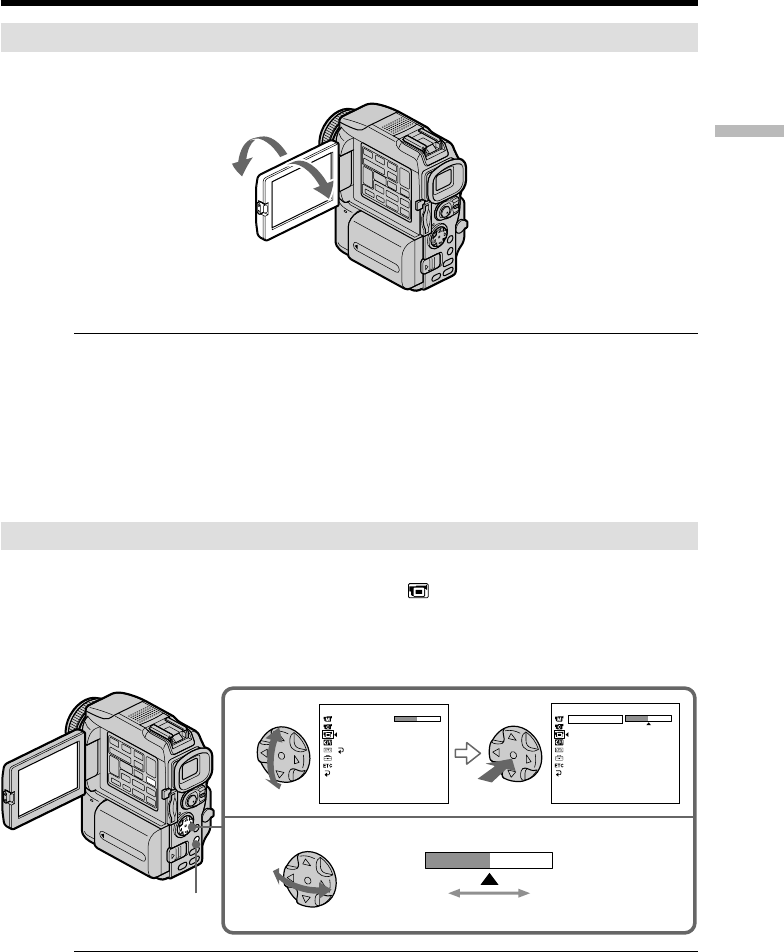
21
Recording – Basics
Adjusting the LCD screen
The LCD panel moves about 90 degrees to the viewfinder side and about 180 degrees to
the lens side.
When closing the LCD panel, set it vertically, and swing it into the camcorder body.
Note
When using the LCD screen except in the mirror mode, the viewfinder automatically
turns off (p. xx).
When you use the LCD screen outdoors in direct sunlight
The LCD screen may be difficult to see. If this happens, we recommend that you use the
viewfinder.
When you adjust the angle of the LCD panel
Make sure if the LCD panel is opened up to 90 degrees.
Adjusting the brightness of the LCD screen
(1)Set the POWER switch to CAMERA, VCR or MEMORY. Press MENU, then
select and decide upon LCD BRIGHT in with the control button. The bar
indicator appears.
(2)Press b/B on the control button to adjust the brightness of the LCD screen,
then press z.
LCD screen backlight
You can change the brightness of the backlight. Select LCD B.L. in the menu settings
when using the battery pack (p. xx).
Recording a picture
180°
90°
1
2
LCD/VF SET
LCD BRIGHT
LCD B.L.
LCD COLOR
VF B.L.
RETURN
[MENU] : END
LCD/VF SET
LCD BRIGHT
LCD B.L.
LCD COLOR
VF B.L.
RETURN
[MENU] : END
To lighten
To darken
MENU
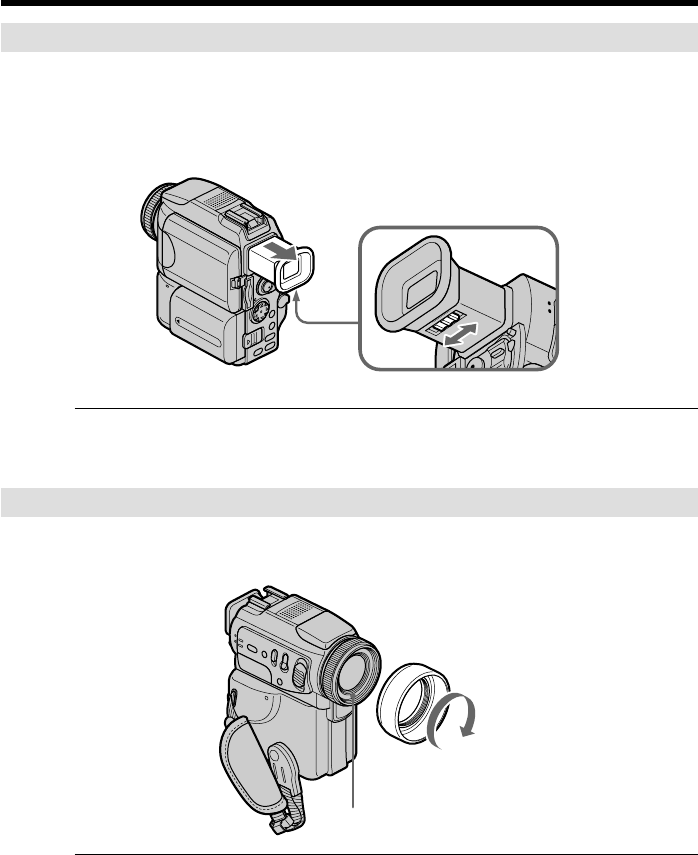
22
Adjusting the viewfinder
If you record pictures with the LCD panel closed, check the picture with the viewfinder.
Adjust the viewfinder lens to your eyesight so that the indicators in the viewfinder
come into sharp focus.
Pull out the viewfinder and move the viewfinder lens adjustment lever.
Viewfinder backlight
You can change the brightness of the backlight. Select VF B.L. in the menu settings
when using the battery pack (p. xx).
Attaching the supplied lens hood
To record fine pictures under strong light, we recommend attaching the lens hood. Also
the lens cap can be attached even with the lens hood on.
Notes
•When you use the Remote Commander and the lens hood, the Remote Commander
may not function properly because the lens hood blocks the infrared rays from the
Remote Commander. In such case, remove the lens hood from your camcorder.
•You cannot attach filters or other objects onto the lens hood. If you do so forcibly, you
will no longer be able to remove filters or other objects from the lens hood.
When you use the filter (optional)
•The shadow of the lens hood may appear in the corners of the screen.
•The flash may not be adjusted correctly if the photocell window is covered.
Recording a picture
Photocell Window
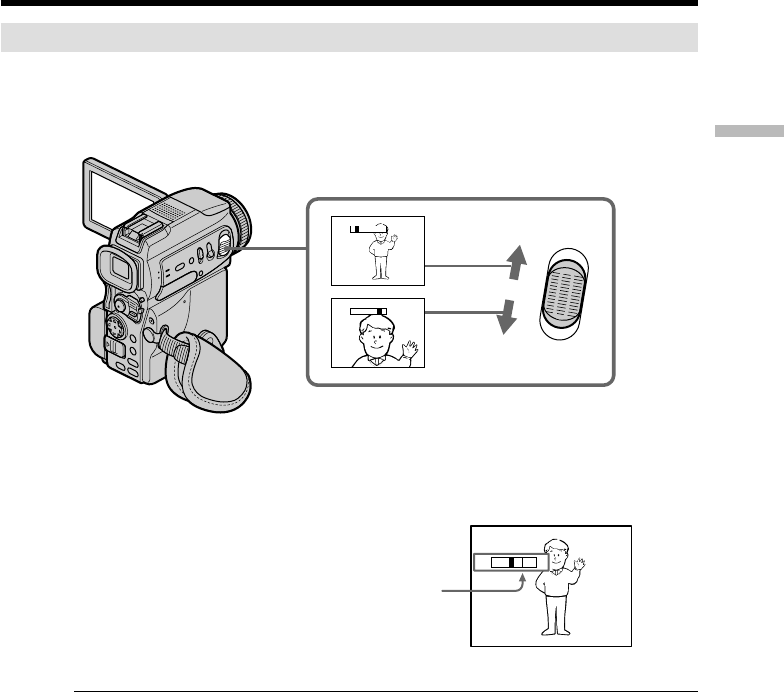
23
Recording – Basics
Using the zoom feature
Move the power zoom lever a little for a slower zoom. Move it further for a faster zoom.
Using the zoom function sparingly results in better-looking recordings.
“T” side: for telephoto (subject appears closer)
“W” side:for wide-angle (subject appears farther away)
To use zoom greater than 10×
Zoom greater than 10× is performed digitally. To activate digital zoom, select the digital
zoom power in D ZOOM in the menu settings (p. xx). The digital zoom function is set to
OFF as a default setting (p. xx).
When you shoot close to a subject
If you cannot get a sharp focus, move the power zoom lever to the “W” side until the
focus is sharp. You can shoot a subject that is at least about 80 cm (about 2 feet 5/8 inch)
away from the lens surface in the telephoto position, or about 1 cm (about 1/2 inch)
away in the wide-angle position.
Notes on digital zoom
•Digital zoom starts to function when zoom exceeds 10×.
•The picture quality deteriorates as you move the power zoom lever towards the “T”
side.
When the POWER switch is set to MEMORY
You cannot use the digital zoom.
Recording a picture
The right side of the bar shows the digital zooming
zone.
The digital zooming zone appears when you select
the digital zoom power in the menu settings.
T
W
T
W
T
W
W
T
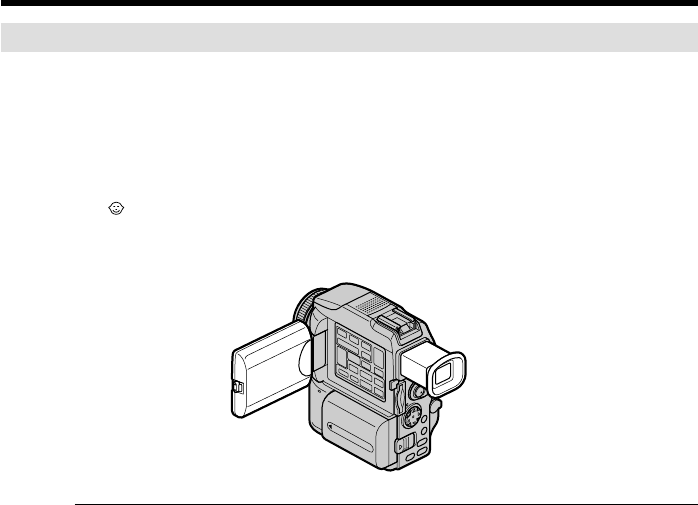
24
Shooting with the Mirror Mode
This feature allows the camera subject to view him-or herself on the LCD screen.
The subject uses this feature to check his or her own image on the LCD screen while you
look at the subject in the viewfinder.
Set the POWER switch to CAMERA or MEMORY.
Pull out the viewfinder and rotate the LCD screen 180 degrees.
The indicator appears in the viewfinder and on the LCD screen.
Xz appears in the standby mode, and z appears in the recording mode. Some of other
indicators appear mirror-reversed and others are not displayed.
Picture in the mirror mode
The picture on the LCD screen is a mirror-image. However, the picture will be normal
when recorded.
During recording in the mirror mode
ZERO SET MEMORY on the Remote Commander does not work.
Recording a picture
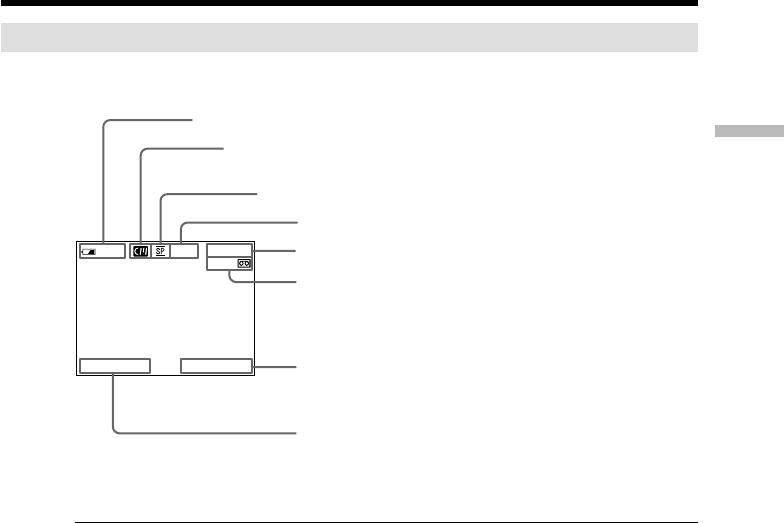
25
Recording – Basics
Indicators displayed in the recording mode
The indicators are not recorded on tapes.
Remaining battery time indicator during recording
The remaining battery time indicator roughly indicates the continuous recording time.
The indicator may not be correct, depending on the conditions in which you are
recording. When you close the LCD panel and open it again, it takes about one minute
for the correct remaining battery time in minutes to be displayed.
Time code
The time code indicates the recording or playback time, “0:00:00” (hours : minutes :
seconds) in CAMERA mode and “0:00:00:00” (hours : minutes : seconds : frames) in
VCR mode. You cannot rewrite only the time code.
Remaining tape indicator
The indicator may not be displayed accurately depending on the tape.
Recording data
The recording data (date/time or various settings when recorded) are not displayed
while recording. However, they are recorded automatically onto the tape. To display
the recording data, press DATA CODE on the Remote Commander during playback.
Recording a picture
Recording mode
Cassette memory
This appears when using a tape with cassette memory.
Time
The time is displayed about five seconds after the
power is turned on.
Date
The date is displayed about five seconds after the
power is turned on.
STBY/REC
Remaining battery time
Time code/Tape counter
Remaining tape
This appears after you insert a cassette and record or
play back for a while.
0:00:01
45min
40
min
REC
JUL 4 2001
12:05:56 AM
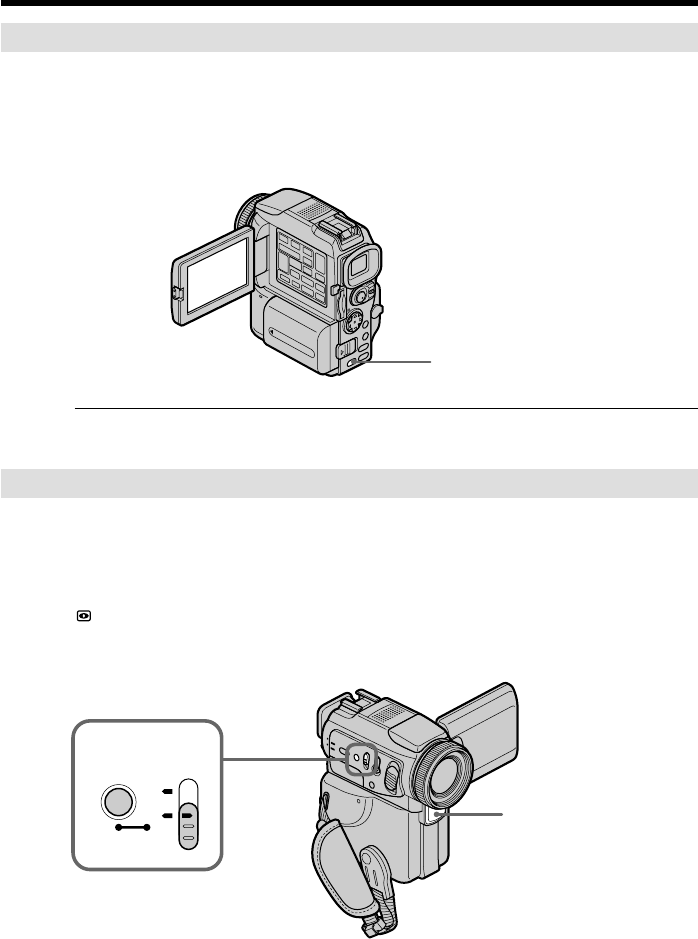
26
Shooting backlit subjects – BACK LIGHT
When you shoot a subject with the light source behind the subject or a subject with a
light background, use the backlight function.
Set the POWER switch to CAMERA or MEMORY, press BACK LIGHT.
The . indicator appears on the screen. To cancel, press BACK LIGHT again.
If you press EXPOSURE when shooting backlit subjects
The backlight function will be canceled.
Shooting in the dark – NightShot/Super NightShot
The NightShot function enables you to shoot a subject in a dark place. For example, you
can satisfactorily record the environment of nocturnal animals for observation when
you use this function.
Set the POWER switch to CAMERA or MEMORY, slide NIGHTSHOT to ON.
and “NIGHTSHOT” indicators flash on the screen. To cancel the NightShot function,
slide NIGHTSHOT to OFF.
Recording a picture
BACK LIGHT
OFF
NIGHTSHOT
NIGHTSHOT
ON
SUPER
NightShot Light emitter

27
Recording – Basics
Using Super NightShot
The Super NightShot mode makes subjects more than 16 times brighter than those
recorded in the NightShot mode.
(1)Set the POWER switch to CAMERA, slide NIGHTSHOT to ON. and
“NIGHTSHOT” indicators flash on the screen.
(2)Press SUPER NIGHTSHOT. and “SUPER NIGHTSHOT” indicators flash
on the screen.
To cancel the Super NightShot mode, press SUPER NIGHTSHOT again.
Using the NightShot Light
The picture will be clearer with the NightShot Light on. To enable the NightShot Light,
set N.S. LIGHT to ON in the menu settings (p. xx).
(The default setting is ON.)
Notes
•Do not use the NightShot function in bright places (ex. the outdoors in the daytime).
This may cause your camcorder to malfunction.
•When you keep NIGHTSHOT set to ON in normal recording, the picture may be
recorded in incorrect or unnatural colors.
•If focusing is difficult with the autofocus mode when using the NightShot function,
focus manually.
•Do not cover the NightShot Light emitter when using the NightShot function.
•Detach the lens hood when you shoot with the NightShot Light since the lens hood
may block the NightShot Light.
While using the NightShot function, you cannot use the following functions:
–Exposure
–PROGRAM AE
–White balance
–HOLOGRAM AF
While using the Super NightShot function
The shutter speed is automatically adjusted depending on the brightness. At that time,
the moving picture may be slow down.
While using the Super NightShot function, you cannot use the following
functions:
–Fader
–Digital effect
–PROGRAM AE
–Exposure
–White balance
–Recording with the flash
–HOLOGRAM AF
When the POWER switch is set to MEMORY
You cannot use the Super NightShot function.
NightShot Light
NightShot Light rays are infrared and so are invisible. The maximum shooting distance
using the NightShot Light is about 3 m (10 feet).
Recording a picture
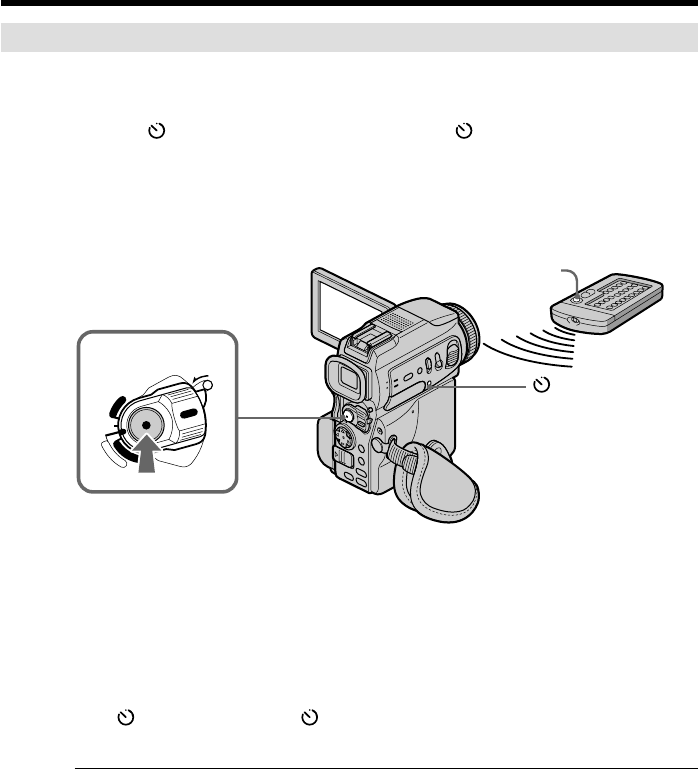
28
Self-timer recording
Recording with the self-timer starts in 10 seconds automatically. You can also use the
Remote Commander for this operation.
(1)Press (self-timer) in the standby mode. The (self-timer) indicator appears
on the screen.
(2)Press START/STOP.
Self-timer starts counting down from ten with a beep sound. In the last
two seconds of the countdown, the beep sound gets faster, then recording
starts automatically.
To stop the countdown
Press START/STOP.
To restart the countdown, press START/STOP again.
To record still images on tapes using the self-timer
Press PHOTO in step 2 (p. xx).
To cancel self-timer recording
Press (self-timer) so that the indicator disappears from the screen while your
camcorder is in the standby mode.
Note
The self-timer recording mode is automatically canceled when:
–Self-timer recording is finished.
–The POWER switch is set to OFF (CHG) or VCR.
When the POWER switch is set to MEMORY
You can also record still images on “Memory Stick”s with the self-timer (p. xx).
Recording a picture
2
LOCK
POWER
V
C
R
M
E
M
O
R
Y
C
A
M
E
R
A
OFF
(CHG)
START/STOP
(self-timer)
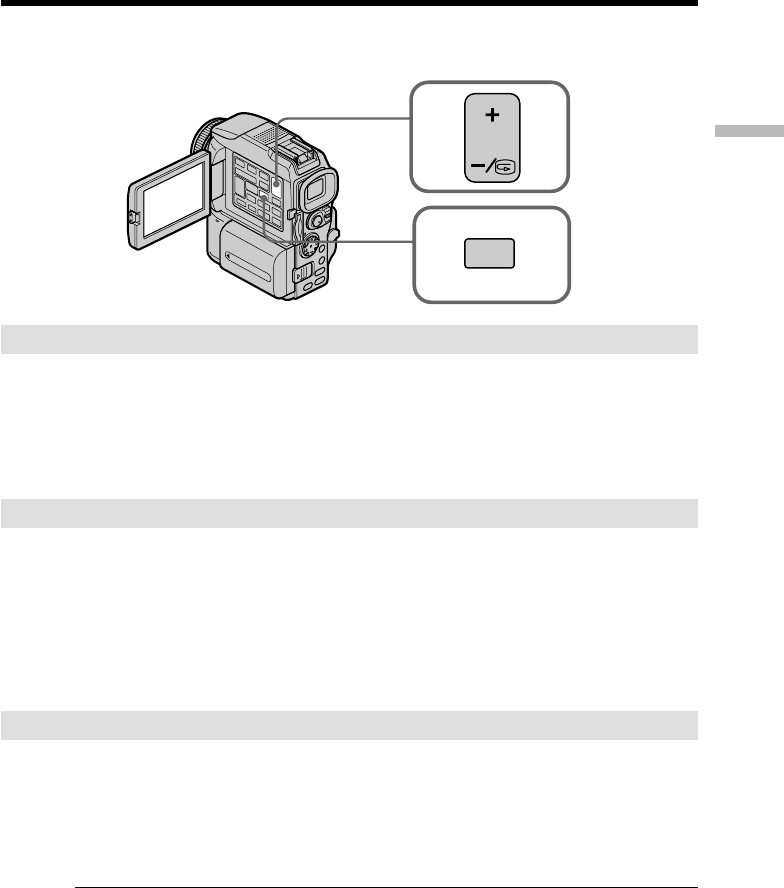
29
Recording – Basics
You can use these buttons to check the recorded picture or shoot so that the transition
between the last recorded scene and the next scene you record is smooth.
END SEARCH
You can go to the end of the recorded section after you record.
Press END SEARCH in the standby mode.
The last five seconds of the recorded section are played back and your camcorder
returns to the standby mode. You can monitor the sound from the speaker or
headphones.
EDITSEARCH
You can search for the next recording start point.
Hold down the + · –/7 side of EDITSEARCH in the standby mode. The recorded
section is played back.
+ : to go forward
–/7: to go backward
Release EDITSEARCH to stop playback. If you press START/STOP, re-recording begins
from the point you released EDITSEARCH. You cannot monitor the sound.
Rec Review
You can check the last recorded section.
Press the –/7 side of EDITSEARCH momentarily in the standby mode.
The section you have stopped most recently will be played back for a few seconds, and
then your camcorder will return to the standby mode. You can monitor the sound from
the speaker or headphones.
End search function
When you use a tape without cassette memory, the end search function does not work
once you eject the cassette after you have recorded on the tape. If you use a tape with
cassette memory, the end search function works even once you eject the cassette.
If a tape has a blank portion in the recorded portions
The end search function may not work correctly.
Checking the recording
– END SEARCH / EDITSEARCH / Rec Review
END
SERCH
EDIT
SEARCH
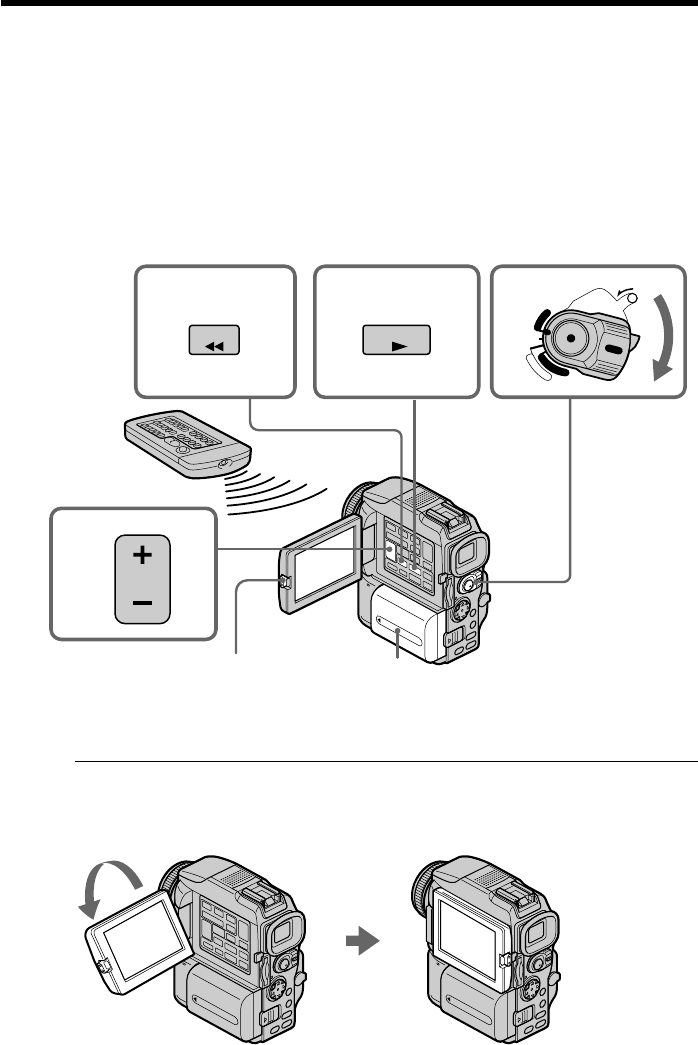
30
You can monitor the playback picture on the screen. If you close the LCD panel, you can
monitor the playback picture in the viewfinder. You can control playback using the
Remote Commander supplied with your camcorder.
(1)Install the power source and insert the recorded tape.
(2)Set the POWER switch to VCR while pressing the small green button.
(3)Open the LCD panel while pressing OPEN.
(4)Press m to rewind the tape.
(5)Press N to start playback.
(6)To adjust the volume, press either of the two buttons on VOLUME.
When you close the LCD panel, sound is muted.
To stop playback
Press x.
When monitoring on the LCD screen
You can turn the LCD panel over and move it back to the camcorder body with the
LCD screen facing out.
— Playback – Basics —
Playing back a tape
45
6
2
1
3
REW PLAY
VOLUME
LOCK
POWER
V
C
R
M
E
M
O
R
Y
C
A
M
E
R
A
OFF
(CHG)
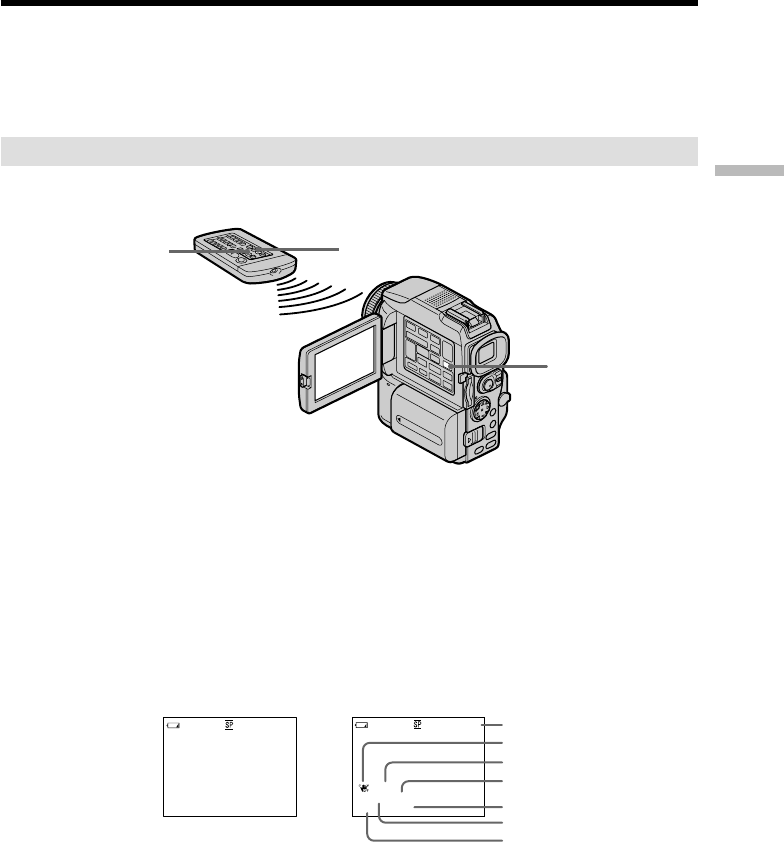
31
Playback – Basics
If you leave the power on for a long time
Your camcorder gets warm. This is not a malfunction.
When you open or close the LCD panel
Open or close the LCD panel vertically.
To display the screen indicators – Display function
Press DISPLAY. The indicators appear on the screen. To make the indicators disappear,
press DISPLAY again.
About date/time and various settings
Your camcorder automatically records not only images on the tape but also the
recording data (date/time or various settings when recorded) (Data code).
Use the Remote Commander for this operation.
1 Set the POWER switch to VCR, then playback a tape.
2Press DATA CODE on the Remote Commander.
The display changes as follows:
date/time t various settings (SteadyShot, exposure, white balance, gain, shutter
speed, aperture value) t no indicator
[a]Tape counter
[b]SteadyShot off
[c]Exposure mode
[d]White balance
[e]Gain
[f]Shutter speed
[g]Aperture value
Not to display various settings
Set DATA CODE to DATE in the menu settings (p. xx).
The display changes as follows when you press DATA CODE on the Remote
Commander: date/time y no indicator
Playing back a tape
DISPLAY
DATA CODE DISPLAY
Date/time Various settings
[g]
[b]
[d]
[e]
[f]
[c]
60 AWB
F1.8 9dB
AUTO
JUL 4 2001
12:05:56 AM
40min
0:00:23:01
40min
0:00:23:01
[a]

32
Playing back a tape
Various settings
Various settings is your camcorder’s information when you have recorded. In the
recording mode, the various settings will not be displayed.
When you use the data code function, bars (-- -- --) appear if:
–A blank portion of the tape is being played back.
–The tape is unreadable due to tape damage or noise.
–The tape was recorded by a camcorder without the date and time set.
Data code
When you connect your camcorder to the TV, the data code appears on the TV screen.
Remaining battery time indicator during playback
The indicator indicates the approximate continuous playback time. The indicator may
not be correct, depending on the conditions in which you are playing back. When you
close the LCD panel and open it again, it takes about one minute for the correct
remaining battery time to be displayed.
Various playback modes
To operate video control buttons, set the POWER switch to VCR.
To playback pause (view a still picture)
Press X during playback. To resume normal playback, press N or X.
To advance the tape
Press M in the stop mode. To resume normal playback, press N.
To rewind the tape
Press m in the stop mode. To resume normal playback, press N.
To change the playback direction
Press on the Remote Commander during playback to reverse the playback direction.
To resume normal playback, press N.
To locate a scene monitoring the picture (picture search)
Keep pressing m or M during playback. To resume normal playback, release the
button.
To monitor the high-speed picture while advancing or
rewinding the tape (skip scan)
Keep pressing m while rewinding or M while advancing the tape. To resume
rewinding or advancing, release the button.
To view the picture at slow speed (slow playback)
Press y on the Remote Commander during playback. For slow playback in the reverse
direction, press , then press y on the Remote Commander. To resume normal
playback, press N.
To view the picture at double speed
Press ×2 on the Remote Commander during playback. For double speed playback in the
reverse direction, press , then press ×2 on the Remote Commander. To resume
normal playback, press N.

33
Playback – Basics
Playing back a tape
To view the picture frame-by-frame
Press C on the Remote Commander in the playback pause mode. For frame-by-frame
playback in the reverse direction, press c. To resume normal playback, press N.
To search the last scene recorded (END SEARCH)
Press END SEARCH in the stop mode. The last five seconds of the recorded portion
plays back and stops.
In the various playback modes
•Sound is muted.
•The previous picture may remain as a mosaic image during playback.
When the playback pause mode lasts for five minutes
Your camcorder automatically enters the stop mode. To resume playback, press N.
Slow playback
The slow playback can be performed smoothly on your camcorder. However, this
function does not work for an output signal through the DV jack.
When you play back a tape in reverse
Horizontal noise may appear at the center, or the top and bottom of the screen. This is
not a malfunction.
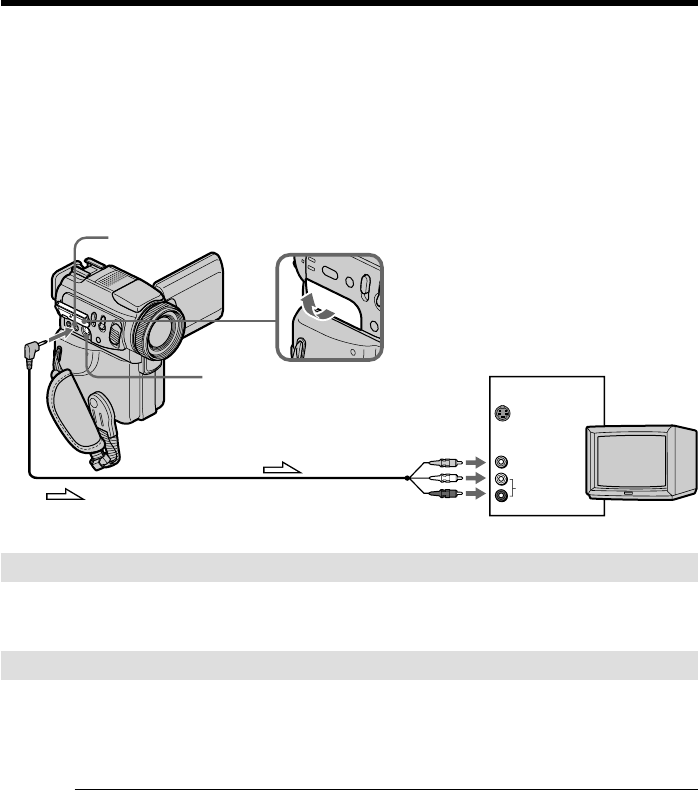
34
Connect your camcorder to your TV with the A/V connecting cable supplied with your
camcorder to watch the playback picture on the TV screen. You can operate the video
control buttons in the same way as when you monitor playback pictures on the screen.
When monitoring the playback picture on the TV screen, we recommend that you
power your camcorder from a wall outlet using the AC power adaptor (p. xx). Refer to
the operating instructions of your TV.
Open the jack cover. Connect your camcorder to the TV using the A/V connecting cable
supplied with your camcorder. Then, set the TV/VCR selector on the TV to VCR.
If your TV is already connected to a VCR
Connect your camcorder to the LINE IN input on the VCR by using the A/V connecting
cable supplied with your camcorder. Set the input selector on the VCR to LINE.
If your TV or VCR is a monaural type
Connect the yellow plug of the A/V connecting cable to the video input jack and the
white or the red plug to the audio input jack on the VCR or the TV. If you connect the
white plug, the sound is L (left) signal. If you connect the red plug, the sound is R
(right) signal.
If your TV has an S video jack
Pictures can be reprodeced more faithfully by using an S video cable (optional). With
this connection, you do not need to connect the yellow (video) plug of the A/V
connecting cable. Connect the S video cable (optional) to the S video jacks on both your
camcorder and the TV.
This connection produces higher quality DV format pictures.
To display the screen indicators on TV
Set DISPLAY to V-OUT/LCD in the menu settings (p. xx).
Then press DISPLAY on your camcorder. To turn off the screen indicators, press
DISPLAY on your camcorder again.
Viewing the recording on TV
TV
S VIDEO
AUDIO/VIDEO
S VIDEO
VIDEO
AUDIO
IN
: Signal flow
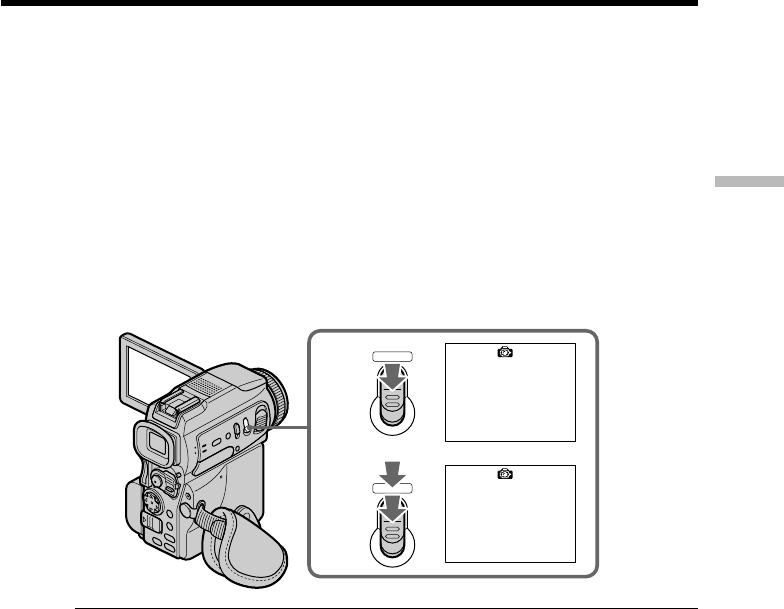
35
Advanced Recording Operations
You can record an still image like a photograph.
You can record about 510 images in the SP mode and about 765 images in the LP mode
on a 60-minute tape.
Besides the operation described here, your camcorder can record still images on
“Memory Stick”s (p. xx).
(1)In the standby mode, keep pressing PHOTO lightly until a still image appears.
The CAPTURE indicator appears. Recording does not start yet.
To change the still image, release PHOTO, select a still image again, and then
press and hold PHOTO lightly.
(2)Press PHOTO deeper.
The still image on the screen is recorded for about seven seconds. The sound
during those seven seconds is also recorded.
The still image is displayed on the screen until recording is completed.
Notes
•During tape photo recording, you cannot change the mode or setting.
•When recording a still image, do not shake your camcorder. The image may fluctuate.
•You cannot use PHOTO during the following operations:
–Fader
–Digital effect
If you record a moving subject with tape photo recording function
When you play back the still image on other equipment, the image may fluctuate.
This is not a malfunction.
To use the tape photo recording function using the Remote Commander
Press PHOTO on the Remote Commander. Your camcorder records an image on the
screen immediately.
To use the tape photo recording function during normal CAMERA recording
You cannot check an image on the screen by pressing PHOTO lightly. Press PHOTO
deeper. The still image is then recorded for about seven seconds, and your camcorder
returns to the standby mode.
To record clear and less fluctuated still images
We recommend that you record on “Memory Stick”s.
— Advanced Recording Operations —
Recording a still image on a tape
– Tape Photo recording
1
•••••••
2
CAPTURE
PHOTO
PHOTO
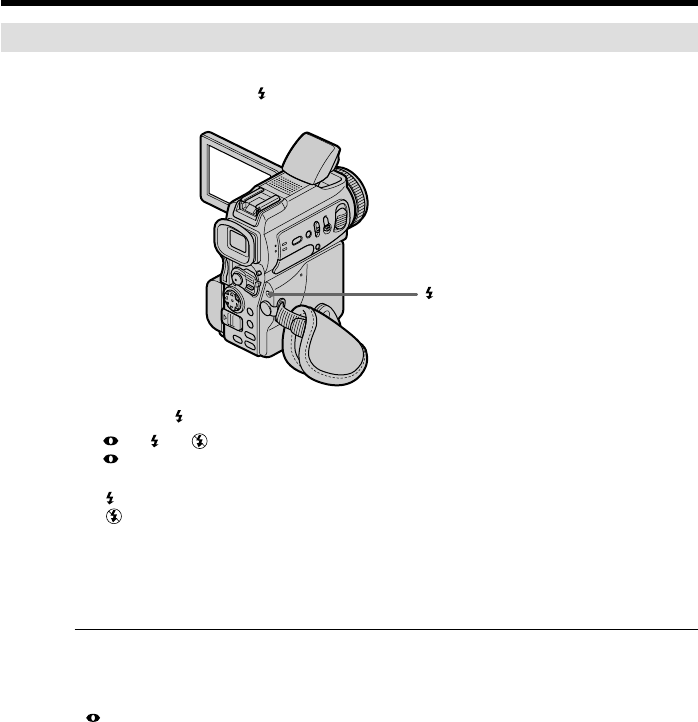
36
Recording images with the flash
The flash pops up automatically. The default setting is auto (no indicator). To change
the flash mode, press the (flash) repeatedly until the flash mode indicator appears on
the screen.
Each press of (flash) changes the indicator as follows:
t t t No indicator
Auto red-eye reduction: The flash fires before recording to reduce the red-eye
phenomenon.
Forced flash: The flash fires regardless of the surrounding brightness.
No flash: The flash does not fire.
The flash is adjusted to the appropriate brightness through the photocell window for
the flash. You can also change FLASH LVL to the desired brightness in the menu
settings (p. xx). Try recording various images to find the most appropriate setting for
FLASH LVL.
Notes
•Attaching the lens hood (supplied) or a conversion lens (optional) may block the light
from the flash or cause lens shadow to appear.
•You cannot use an external flash (optional) and the built-in flash at the same time.
• (auto red-eye reduction) may not produce the desired effect depending on
individual differences, the distance to the subject, the subject not looking at the pre-
recording flash or other conditions.
•The flash effect cannot be obtained easily when you use forced flash in a bright
location.
•When you record images with the flash, sound may not be recorded clearly.
•When recording with the flash, it takes longer to prepare for image capture. This is
because your camcorder starts to charge power for firing after the flash pops up.
Darken the surroundings by covering the lens part, and press PHOTO lightly so that
your camcorder starts to charge power after the flash pops up.
•If it is not easy to focus on the subject automatically, for example, when recording in
the dark, use the focal distance information (p. xx) for focusing manually.
Recording a still image on a tape – Tape Photo recording
(flash)

37
Advanced Recording Operations
When you record images with the flash
The possible shooting distance using the built-in flash is shorter than when you record
on “Memory Stick”s.
When playing back images recorded with the flash on other equipment
These images may flicker.
If you leave your camcorder for five or more minutes after disconnecting the
power source
Your camcorder returns to the default setting (auto).
You cannot shoot images with the flash during the following operations:
–Low lux of PROGRAM AE
–Super NightShot
–Digital effect
–Fader
–Recording
The flash does not fire even if you select auto (no indicator) and (auto red-eye
reduction) during the following operations:
–Exposure
–NightShot
–Spotlight of PROGRAM AE
–Sunset & moon of PROGRAM AE
–Landscape of PROGRAM AE
When you use an external flash (optional) which does not have the auto red-eye
reduction function
You cannot select the auto red-eye reduction.
Recording a still image on a tape – Tape Photo recording
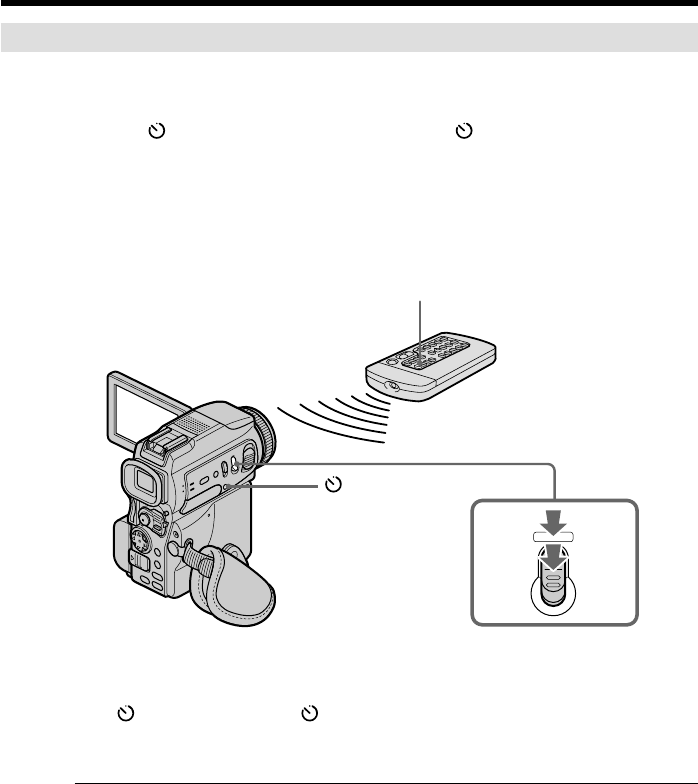
38
Self-timer recording
You can record still images on tapes with the self-timer. You can also use the Remote
Commander for this operation.
(1)Press (self-timer) in the standby mode. The (self-timer) indicator appears
on the screen.
(2)Press PHOTO deeper.
Self-timer starts counting down from 10 with a beep sound. In the last
two seconds of the countdown, the beep sound gets faster, then recording
starts automatically.
To cancel self-timer recording
Press (self-timer) so that the indicator disappears from the screen while your
camcorder is in the standby mode. You cannot cancel the self-timer recording using the
Remote Commander.
Note
The self-timer recording mode is automatically canceled when:
–Self-timer recording is finished.
–The POWER switch is set to OFF (CHG) or VCR.
Recording a still image on a tape – Tape Photo recording
PHOTO
2PHOTO
(self-timer)
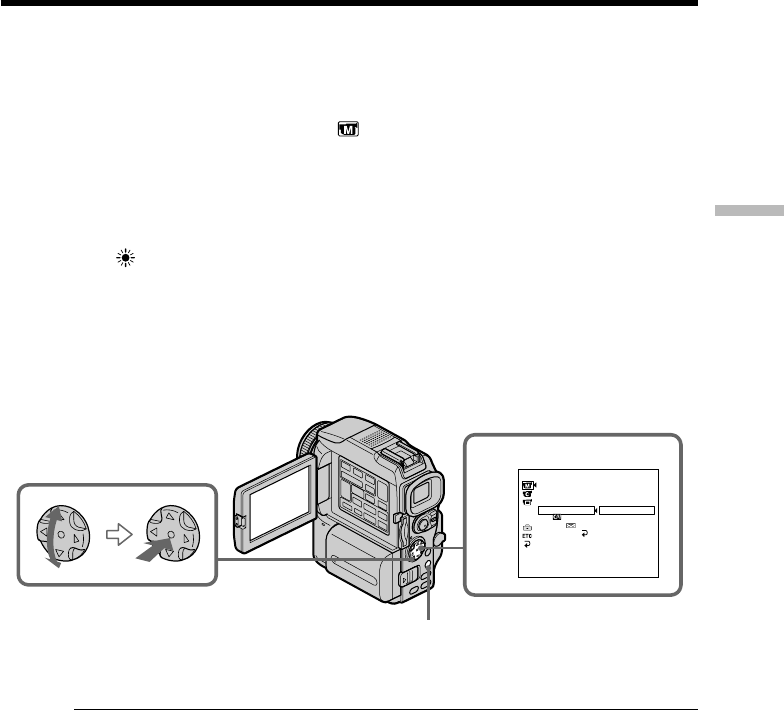
39
Advanced Recording Operations
You can manually adjust and set the white balance. This adjustment makes white
subjects look white and allows more natural color balance. Normally white balance is
automatically adjusted.
(1)Set the POWER switch to CAMERA or MEMORY. Press MENU, then select
and decide upon WHT BAL in with the control button (p. xx).
(2)Select and decide upon the desired white balance mode with the control
button.
HOLD :
Recording a single-colored subject or background
OUTDOOR :
•Recording a sunset/sunrise, just after sunset, just before sunrise, neon signs, or
fireworks
•Under a color matching fluorescent lamp
n INDOOR :
•Lighting condition changes quickly
•Too bright place such as photography studios
•Under sodium lamps or mercury lamps
To return to the automatic white balance mode
Set WHT BAL to AUTO in the menu settings.
If the picture is being taken in a studio lit by TV lighting
We recommend that you record in the n indoor mode.
When you record under fluorescent lighting
Use the automatic white balance or hold mode.
Your camcorder may not adjust the white balance correctly in the n indoor mode.
In the automatic white balance mode
Point your camcorder at a white subject for about 10 seconds after setting the POWER
switch to CAMERA to get a better adjustment when:
–You detach the battery for replacement.
–You bring your camcorder to the outdoors from the interior of a house holding the
exposure, or vice versa.
In the hold white balance mode
Set the white balance to AUTO and reset to HOLD after a few seconds when:
–You change the PROGRAM AE mode.
–You bring your camcorder to the outdoors from the interior of a house, or vice versa.
Adjusting the white balance manually
MANUA L SET
AUTO
HOLD
PROGRAM AE
P
EFFEC T
DEFFECT
W
HT BAL
I NDOOR
OUTDOOR
A U T O S H T R
RETURN
[
MENU
] :
END
1
MENU
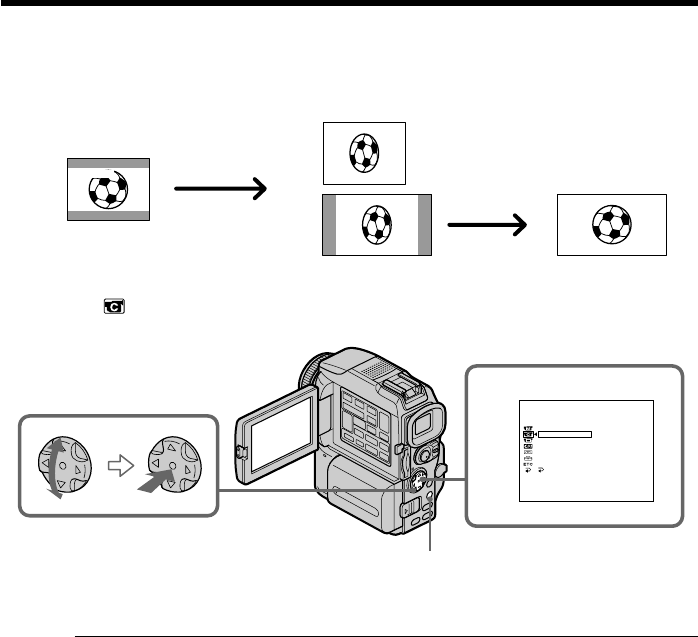
40
You can record a 16:9 wide picture to watch on the 16:9 wide-screen TV (16:9WIDE).
Black bands appear on the screen during recording in 16:9WIDE mode [a]. The picture
during a playback on a normal TV [b] or on a wide-screen TV [c] is compressed in the
widthwise direction. If you set the screen mode of the wide-screen TV to the full mode,
you can watch pictures of normal images [d].
(1)In the standby mode, press MENU, then select and decide upon 16:9WIDE in
with the control button (p. xx).
(2)Select and decide upon ON with the control button.
To cancel the wide mode
Set 16:9WIDE to OFF in the menu settings.
In the wide mode
You cannot select the following functions:
– OLD MOVIE
– BOUNCE
During recording
You cannot select or cancel the wide mode. When you cancel the wide mode, set your
camcorder to the standby mode and then set 16:9WIDE to OFF in the menu settings.
Connection for a TV
Pictures recorded in the 16:9WIDE mode automatically appear on the TV screen at full
size when:
– you connect your camcorder to a TV that is compatible with the video ID (ID-1/ID-2)
system.
– you connect your camcorder to the S video jack on the TV.
ID-1 system
The ID-1 system sends aspect ratio information (16:9, 4:3, or letter box) with video
signals. If you connect a TV compatible with the ID-1 system, the screen size is
automatically selected.
ID-2 system
The ID-2 system sends a copyright protection signal with ID-1 signals inserted between
video signals when you connect your camcorder to other equipment using an A/V
connecting cable.
Using the wide mode
[a]
[c]
[b]
[d]
16:9
WIDE
2
CAMERA SET
NO
STEADYSHOT
DZOOM
16
:
9
W
IDE
NRUTER
[
MENU
] :
END
N
.
S
.
LIGHT
INT
.
REC
FLASH LVL
FRAME REC
MENU
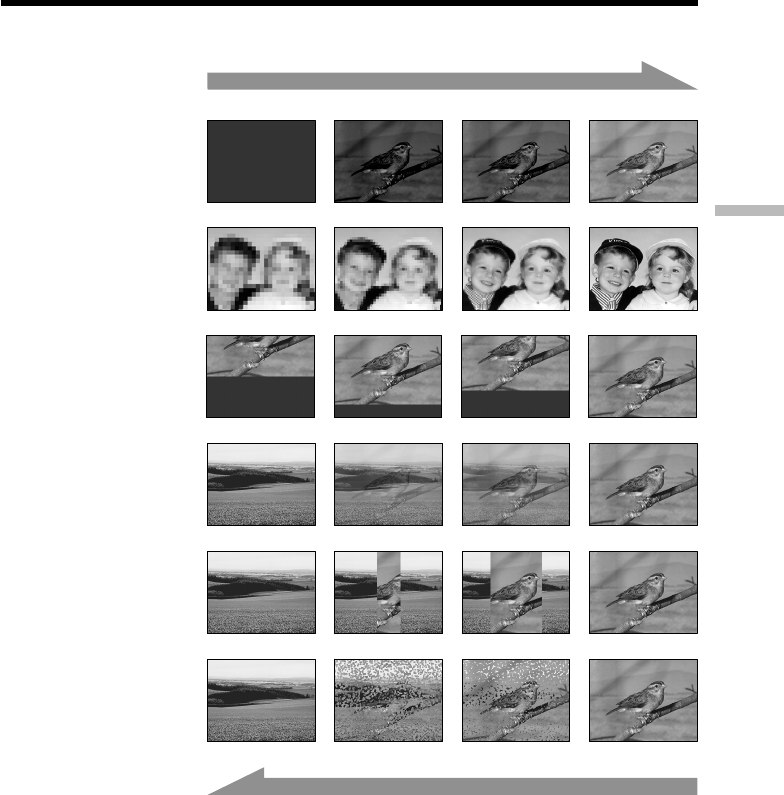
41
Advanced Recording Operations
You can fade in or out to give your recording a professional appearance.
MONOTONE
When fading in, the picture gradually changes from black-and-white to color.
When fading out, the picture gradually changes from color to black-and-white.
1) You can use the bounce function when D ZOOM is set to OFF in the menu settings.
2) Fade in only.
Using the fader function
FADER
OVERLAP2)
WIPE2)
DOT2)
[a]
RECSTBY
RECSTBY
[b]
M. FADER
(mosaic)
BOUNCE1) 2)
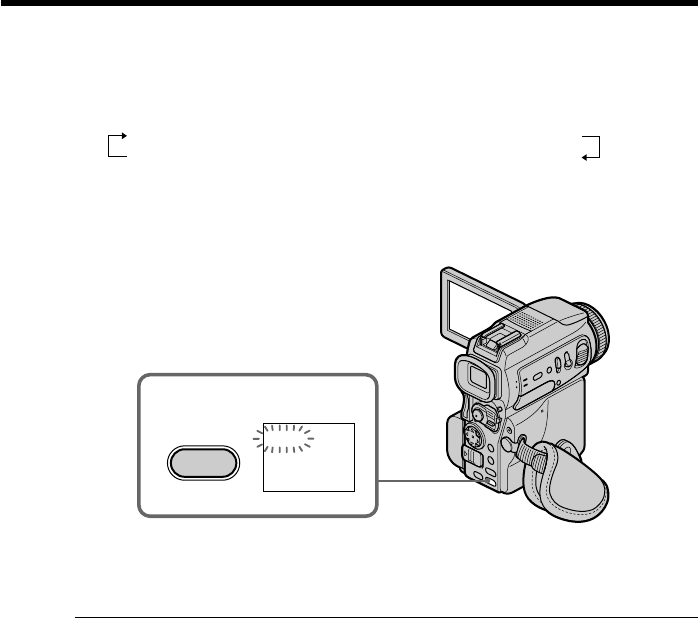
42
(1) When fading in [a]
In the standby mode, press FADER until the desired fader indicator flashes.
When fading out [b]
In the recording mode, press FADER until the desired fader indicator flashes.
The indicator changes as follows:
FADER tM. FADER tBOUNCE tMONOTONE
no indicator TDOT TWIPE TOVERLAP
The last selected fader mode is indicated first of all.
(2)Press START/STOP. The fader indicator stops flashing.
After the fader in/out is carried out, your camcorder automatically returns to
normal mode.
To cancel the fader function
Before pressing START/STOP, press FADER until the indicator disappears.
Note
You cannot use the following functions while using the fader function. Also, you cannot
use the fader function while using the following functions:
–Digital effect
–Low lux of PROGRAM AE (Overlap, Wipe, or Dot function only) (The indicator
flashes.)
–Super NightShot
–Tape photo recording
–Interval recording
–Cut recording
When you select OVERLAP, WIPE, or DOT
Your camcorder automatically stores the image recorded on a tape. As the image is
being stored, the indicators flash fast, and the playback picture disappears. At this
stage, the picture may not be recorded clearly, depending on the tape condition.
When you set the POWER switch to MEMORY
You cannot use the fader function.
Using the fader function
1
FADER
FADER

43
Advanced Recording Operations
While using the bounce function, you cannot use the following functions:
–Focus
–Zoom
–Picture effect
–Exposure
Note on the bounce function
The BOUNCE indicator does not appear in the following mode or functions:
–D ZOOM is activated in the menu settings
–Wide mode
–Picture effect
–PROGRAM AE
Using the fader function
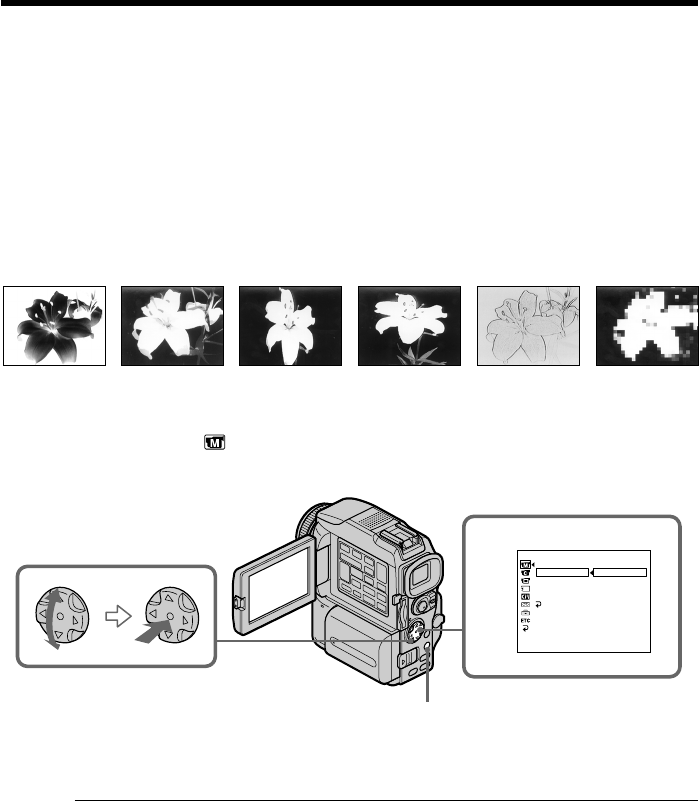
44
You can digitally process images to obtain special effects like those in films or on TV.
NEG. ART [a] : The color and brightness of the picture are reversed.
SEPIA : The picture gets sepia.
B&W : The picture appears in monochrome (black-and-white).
SOLARIZE [b] : The light intensity is clearer, and the picture looks like an illustration.
SLIM [c] : The picture expands vertically.
STRETCH [d] : The picture expands horizontally.
PASTEL [e] : The contrast of the picture is emphasized, and the picture looks like an
animated cartoon.
MOSAIC [f] : The picture gets mosaic-patterned.
(1)Set the POWER switch to CAMERA. Press MENU, then select and decide upon
P EFFECT in with the control button (p. xx).
(2)Select and decide upon the desired picture effect mode with the control button.
To cancel the picture effect function
Set P EFFECT to OFF in the menu settings.
While using the picture effect function
You cannot select OLD MOVIE mode with DIGITAL EFFECT.
When you set the POWER switch to OFF (CHG)
The picture effect is automatically canceled.
Using special effects – Picture effect
[a] [b] [c] [d] [e] [f]
MANUA L SE T
.
FFO TRAGEN AIPES
W
&B EZIRALOS MILS HCTERTS LETSAP CIASOM
DEFFECT
PROGRAM AE
PEFFECT
LABTH
W
RTHSOTUA NRUTER
[
MENU
] :
END
1
MENU
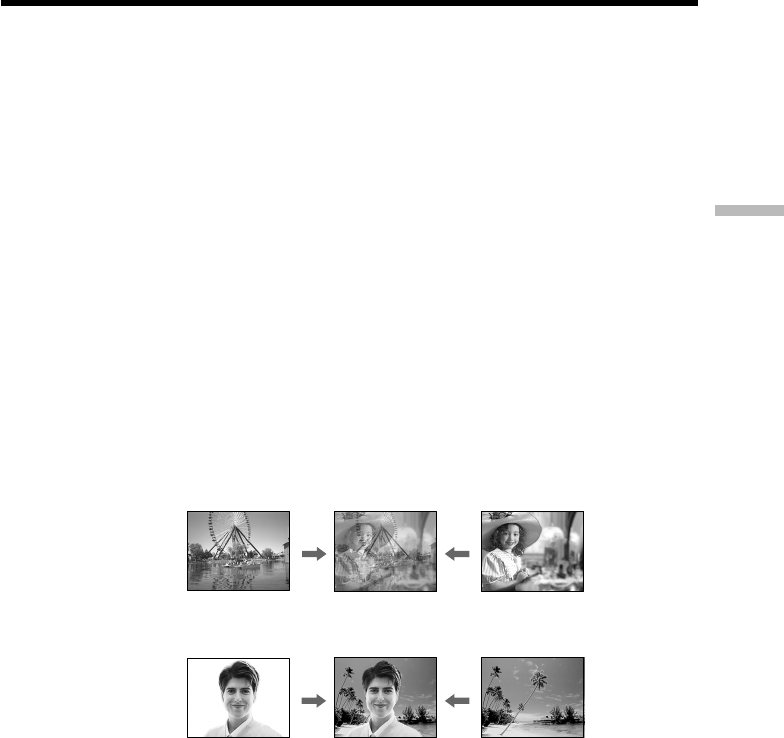
45
Advanced Recording Operations
Using special effects – Digital effect
You can add special effects to recorded pictures using the various digital functions. The
sound is recorded normally.
STILL
You can record a still image so that it is superimposed on a moving picture.
FLASH (FLASH MOTION)
You can record still images successively at constant intervals.
LUMI. (LUMINANCEKEY)
You can swap a brighter area in a still picture with a moving picture.
TRAIL
You can record the picture so that an incidental image like a trail is left.
SLOW SHTR (SLOW SHUTTER)
You can slow down the shutter speed. The slow shutter mode is good for recording
dark pictures more brightly.
OLD MOVIE
You can add an old movie type atmosphere to pictures. Your camcorder automatically
sets the wide mode to ON and picture effect to SEPIA, and the appropriate shutter
speed.
STILL
LUMI.
Still image Moving picture
Still image Moving picture
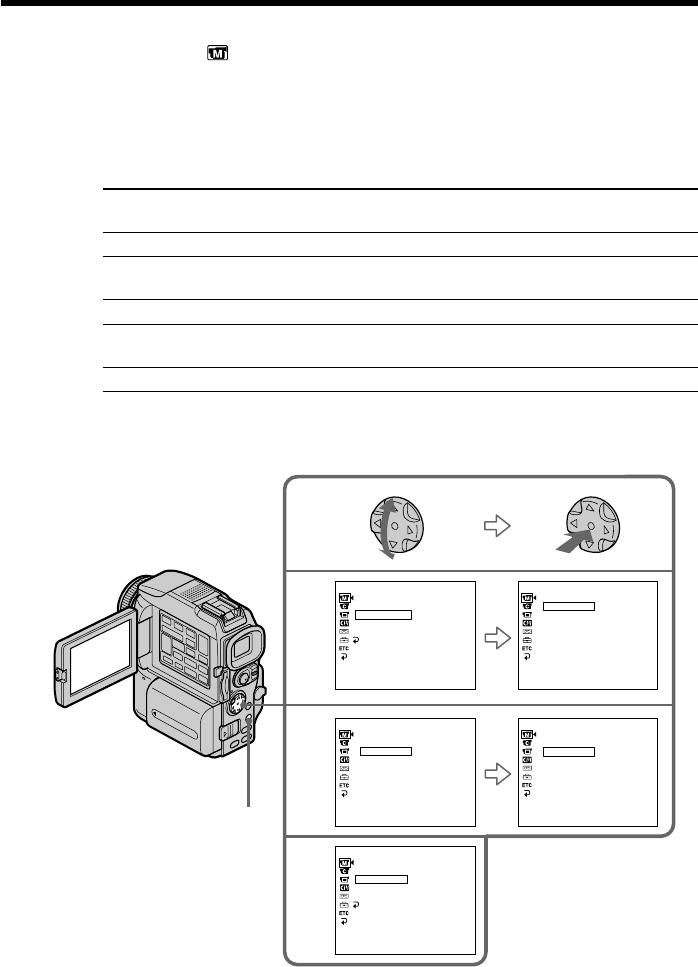
46
(1)Set the POWER switch to CAMERA. Press MENU, then select and decide upon
D EFFECT in with the control button (p. xx).
(2)Select and decide upon the desired digital effect mode with the control button.
The bars appear. In the STILL or LUMI. mode, the still image is stored in
memory.
(3)Adjust and dicide upon the effect with the control button.
Items to be adjusted
STILL The rate of the still image you want to superimpose on the moving
picture
FLASH The interval of flash motion
LUMI. The color scheme of the area in the still image which is to be
swapped with a moving picture
TRAIL The time until the incidental image vanishes
SLOW SHTR Shutter speed. The larger the shutter speed number, the slower the
shutter speed becomes.
OLD MOVIE No adjustment necessary
The more bars there are on the screen, the stronger the digital effect. The bars
appear in the following modes: STILL, FLASH, LUMI. and TRAIL.
To cancel the digital effect function
Set D EFFECT to OFF in the menu settings.
Using special effects – Digital effect
2
MANUA L SET
OFF
ST I LL
FLASH
TRA I L
DEFFECT
[
MENU
] :
END
LUMI
.
MANUA L SET
[
MENU
] :
END
RETURN
MANUA L SET
OFF
ST I LL
FLASH
TRA I L
DEFFECT
[
MENU
] :
END
LUMI
.
MANUA L SET
[
MENU
] :
END
PEFFECT
DEFFECT
SLO
W
SHTR
OLD MOV I E
PROGRAM AE
ST I LL
IIIIIIIIIIIIIIII
AUTO SHTR
RTHS
W
OLS EIVOMDLO
W
HT BAL
3
MANUA L SET
[
MENU
] :
END
PROGRAM AE
PEFFECT
DEFFECT
W
HT BAL
AUTO SHTR
RETURN
1
IIIIIIII••••••••
OFF
LLITS
TCEFFED
MENU

47
Advanced Recording Operations
Using special effects – Digital effect
Notes
•The following functions do not work during digital effect:
–Fader
–Low lux of PROGRAM AE (The indicator flashes.)
–Tape photo recording
–Super NightShot
•The PROGRAM AE function does not work in the slow shutter mode.
•The following functions do not work in the old movie mode:
–Wide mode
–Picture effect
–PROGRAM AE
When you set the POWER switch to OFF (CHG)
The digital effect is automatically canceled.
When recording in the slow shutter mode
Auto focus may not be effective. Focus manually using a tripod.
Shutter speed
Shutter speed number Shutter speed
SLOW SHTR 1 1/30
SLOW SHTR 2 1/15
SLOW SHTR 3 1/8
SLOW SHTR 4 1/4
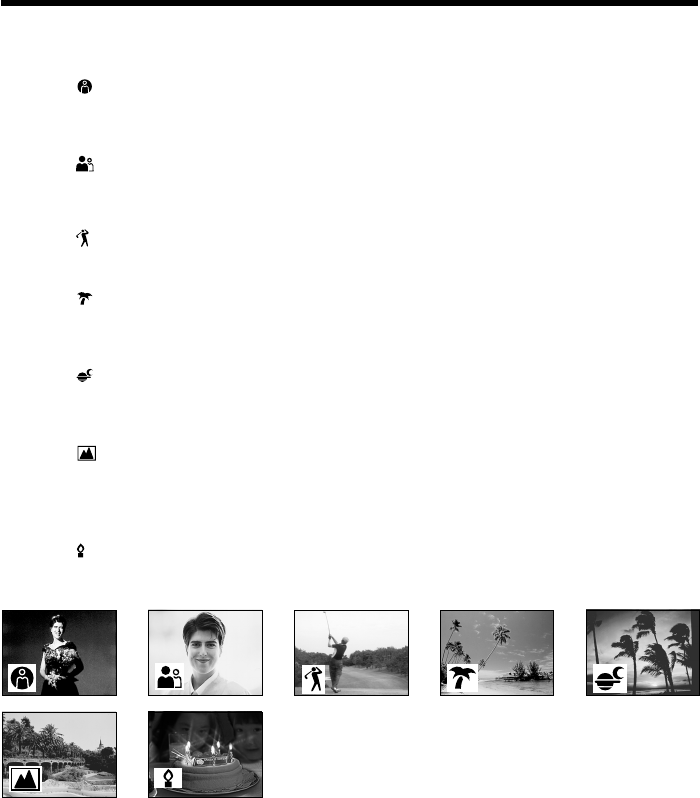
48
Using the PROGRAM AE function
You can select PROGRAM AE (Auto Exposure) mode to suit your specific shooting
requirements.
Spotlight
This mode prevents peoples’ faces, for example, from appearing excessively white
when shooting subjects lit by strong light in the theater.
Soft portrait
This mode brings out the subject while creating a soft background for subjects such as
people or flowers.
Sports lesson
This mode minimizes shake on fast-moving subjects such as in tennis or golf.
Beach & ski
This mode prevents peoples’ faces from appearing dark in strong light or reflected light,
such as at a beach in midsummer or on a ski slope.
Sunset & moon
This mode allows you to maintain atmosphere when you are recording sunsets, general
night views, fireworks displays and neon signs.
Landscape
This mode is for when you are recording distant subjects such as mountains, and
prevents your camcorder from focusing on glass or metal mesh in windows when you
are recording a subject behind glass or a screen.
Low lux
This mode makes subjects brighter in insufficient light.
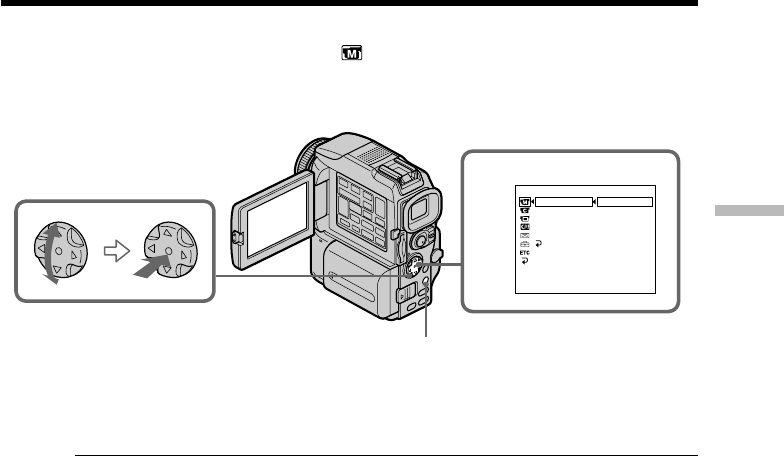
49
Advanced Recording Operations
(1)Set the POWER switch to CAMERA or MEMORY. Press MENU select and
decide upon PROGRAM AE in in the menu settings with the control
button (p. xx).
(2)Select and decide upon the desired PROGRAM AE mode with the control
button.
To cancel the PROGRAM AE function
Select PROGRAM AE to AUTO in the menu settings.
Notes
•Because your camcorder is set to focus only on subjects in the middle to far distance,
you cannot take close-ups in the following modes:
–Spotlight
–Sports lesson
–Beach & ski
•Your camcorder is set to focus only on distant subjects in the following modes:
–Sunset & moon
–Landscape
•The following functions do not work in the PROGRAM AE mode:
–Slow shutter
–Old movie
–Bounce
•The following functions do not work in the low lux mode:
–Digital effect
–Overlap
–Wipe
–Dot
–Recording with the flash
•When you set the POWER switch to MEMORY, the following modes do not work
(The indicator flashes.):
–Low lux
–Sports lesson
•The PROGRAM AE function does not work in the following cases. (The indicator
flashes.)
–To set NIGHTSHOT to ON
–To record images on a “Memory Stick” using the MEMORY MIX function.
Using the PROGRAM AE function
MANUA L SET AUTO
SPOTL I GHT
PORTRA I T
PROGRAM AE
PEFFECT
DEFFECT
WH T B A L
AUTO SHTR
RETURN
[
MENU
] :
END
BEACH&SK I
SPORTS
SUNSETMOON
LANDSCAPE
LO
W
LUX
1
MENU

50
Using the PROGRAM AE function
While WHT BAL is set to AUTO in the menu settings
The white balance is adjusted even if the PROGRAM AE function is selected.
Even if the PROGRAM AE function is selected
You can adjust the exposure.
If you are recording under a discharge tube such as a fluorescent lamp, sodium
lamp or mercury lamp
Flickering or changes in color may occur in the following modes. If this happens, turn
the PROGRAM AE function off.
–Soft portrait
–Sports lesson
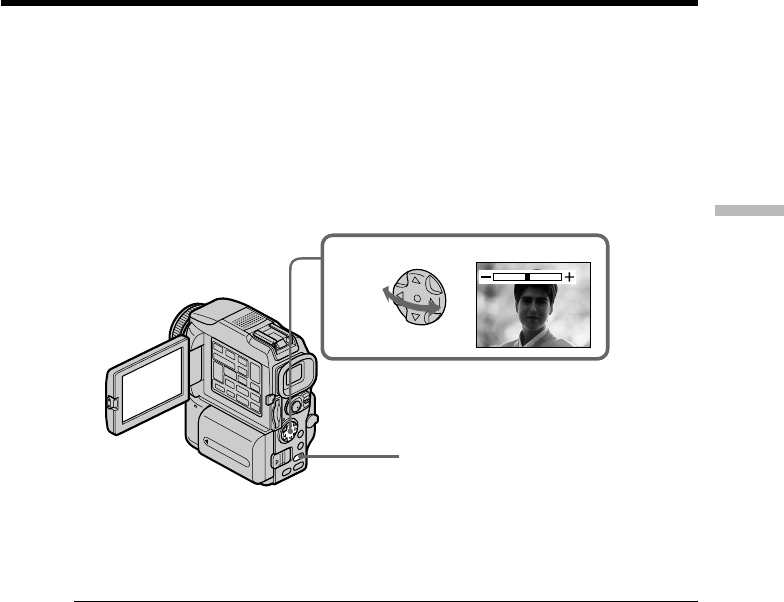
51
Advanced Recording Operations
You can manually adjust and set the exposure. Normally exposure is automatically
adjusted. Adjust the exposure manually in the following cases:
–The subject is backlit
–Bright subject and dark background
–To record dark pictures (e.g. night scenes) faithfully
(1)Set the POWER switch to CAMERA or MEMORY, press EXPOSURE.
The exposure indicator appears.
(2)Push b/B on the control button to adjust the brightness.
To return to the automatic exposure mode
Press EXPOSURE.
Note
When you adjust the exposure manually, the backlight function does not work.
Your camcorder automatically returns to the automatic exposure mode:
–If you change the PROGRAM AE mode.
–If you slide NIGHTSHOT to ON.
Adjusting the exposure manually
2
EXPOSURE
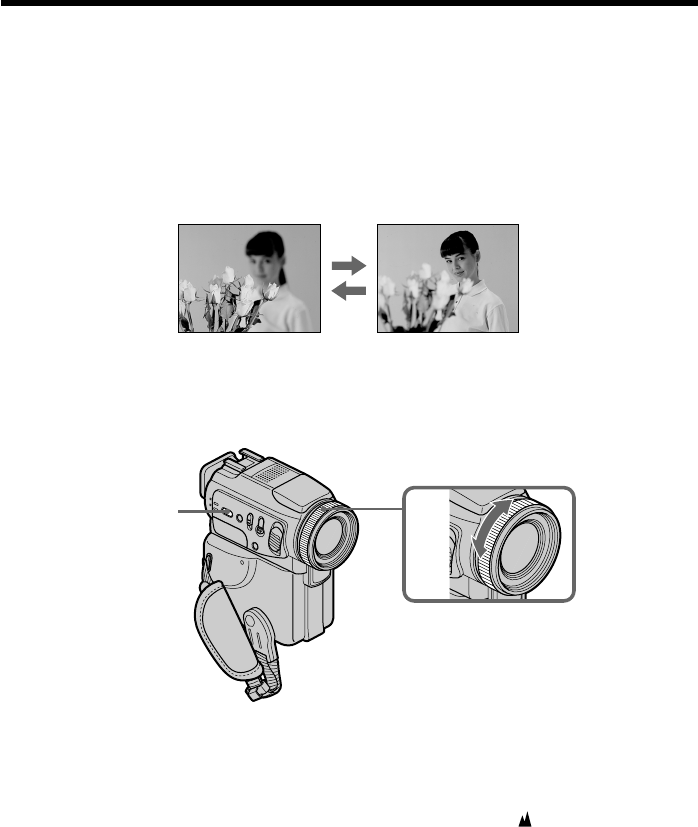
52
You can gain better results by manually adjusting the focus in the following cases.
Normally, focus is automatically adjusted:
•The autofocus mode is not effective when shooting:
–subjects through glass coated with water droplets
–horizontal stripes
–subjects with little contrast with backgrounds such as walls and sky
•When you want to change the focus from a subject in the foreground to a subject in
the background.
•Shooting a stationary subject when using a tripod.
(1)Set the POWER switch to CAMERA or MEMORY, press FOCUS lightly.
The 9 indicator appears.
(2)Turn the focus ring to sharpen focus.
To return to the autofocus mode
Press FOCUS lightly to turn off the indicator.
To record distant subjects
When you press FOCUS down firmly, the lens focuses on and indicator appears.
When you release FOCUS, your camcorder returns to the manual focus mode. Use this
mode when your camcorder focuses on near objects even though you are trying to
shoot a distant object.
Focusing manually
2
FOCUS

53
Advanced Recording Operations
To focus precisely
It is easier to focus on the subject if you adjust the zoom to shoot at the “W” (wide-
angle) after focusing at the “T” (telephoto) position.
When you shoot close to the subject
Focus at the end of the “W” (wide-angle) position.
9 changes as follows:
when recording a distant subject
when the subject is too close to focus on
Focal distance information is displayed for about three seconds on the screen in
the following cases:
–When switching the focus adjustment mode from autofocus to manual
–When turning the focus ring
Focal distance information
–This information aids focusing if it is not easy to focus on the subject, for example,
when recording in the dark. Use this information as a rough guide to get a sharp
focus.
–You cannot get correct information if you have attached a conversion lens to your
camcorder.
Focusing manually
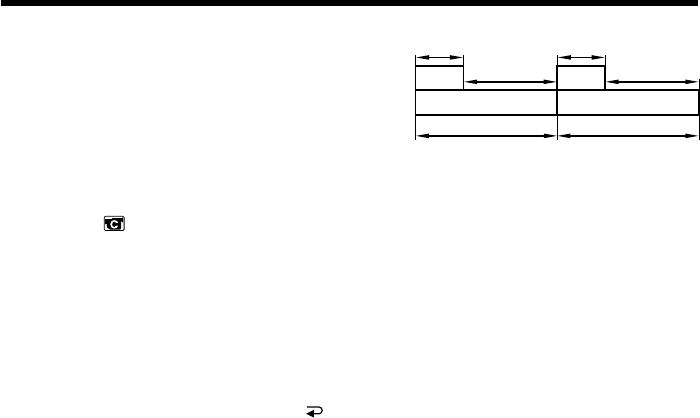
54
You can make a time-lapse recording by
setting the camcorder to automatically record
and standby sequentially. You can achieve an
excellent recording for flowering, emergence,
etc., with this function.
(1)In the standby mode, press MENU, then select and decide upon INT. REC in
with the control button (p. xx).
(2)Select and decide upon SET with the control button.
(3)Set INTERVAL and REC TIME.
1 Select and decide upon INTERVAL with the control button.
2 Select and decide upon the desired interval time with the control button.
The time: 30SEC y 1MIN y 5MIN y 10MIN
3 Select and decide upon REC TIME with the control button.
4 Select and decide upon the desired recording time with the control button.
The time: 0.5SEC y 1SEC y 1.5SEC y 2SEC
5 Select and decide upon RETURN with the control button.
(4)Select and decide upon ON with the control button.
(5)Press MENU to erase the menu display. The INTERVAL indicator flashes.
(6)Press START/STOP to start interval recording. The INTERVAL indicator lights
up.
Interval recording
10 min10 min
1 s 1 s
9 min 59 s 9 min 59 s
[a][a]
[b][b]
Example
[a]REC TIME
[b]INTERVAL
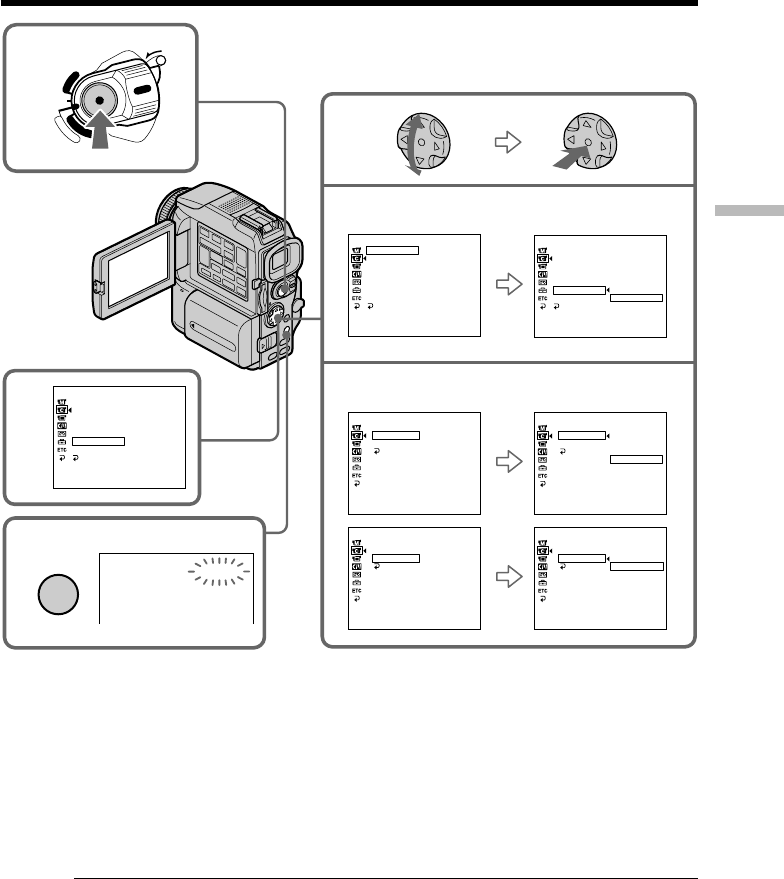
55
Advanced Recording Operations
Interval recording
4
6
CAMERA SET
D ZOOM
16 : 9W
I
DE
STEADYSHOT
N.
S.
L
I
GHT
FRAME REC
I
NT. REC
FLASH
LVL
RETURN
ON
[MENU] : END
LOCK
POWER
V
C
R
M
E
M
O
R
Y
C
A
M
E
R
A
OFF
(CHG)
5
I
NTERVAL
STBY
MENU
CAMERA SET
D ZOOM OFF
16 : 9W
I
DE
STEADYSHOT
N.
S.
L
I
GHT
FRAME REC
I
NT. REC
FLASH
LVL
RETURN
[MENU] : END
CAMERA SET
D ZOOM
16 : 9W
I
DE
STEADYSHOT
N.
S.
L
I
GHT
FRAME REC
I
NT. REC
FLASH
LVL
RETURN
ON
OFF
SET
[MENU] : END
CAMERA SET
I
NT. REC
I
NTERVAL
REC T
I
ME
RETURN
30SEC
[MENU] : END
CAMERA SET
I
NT. REC
I
NTERVAL
REC T
I
ME
RETURN
30SEC
1M
I
N
5M
I
N
10M
I
N
[MENU] : END
CAMERA SET
I
NT. REC
I
NTERVAL
REC T
I
ME
RETURN 0
.
5SEC
[MENU] : END
CAMERA SET
I
NT. REC
I
NTERVAL
REC T
I
ME
RETURN 0
.
5SEC
1SEC
1
.
5SEC
2SEC
[MENU] : END
2
3
To cancel the interval recording
Perform either of the following:
–Set INT. REC to OFF in the menu settings.
–Set the POWER switch to other than CAMERA.
To perform normal recording during the interval recording
You can perform normal recording only once during INTERVAL.
Press START/STOP. The INTERVAL indicator flashes, and normal recording starts. To
stop normal recording, press START/STOP again.
On recording time
There may be a discrepancy in recording time of up to +/– six frames from the selected
time.
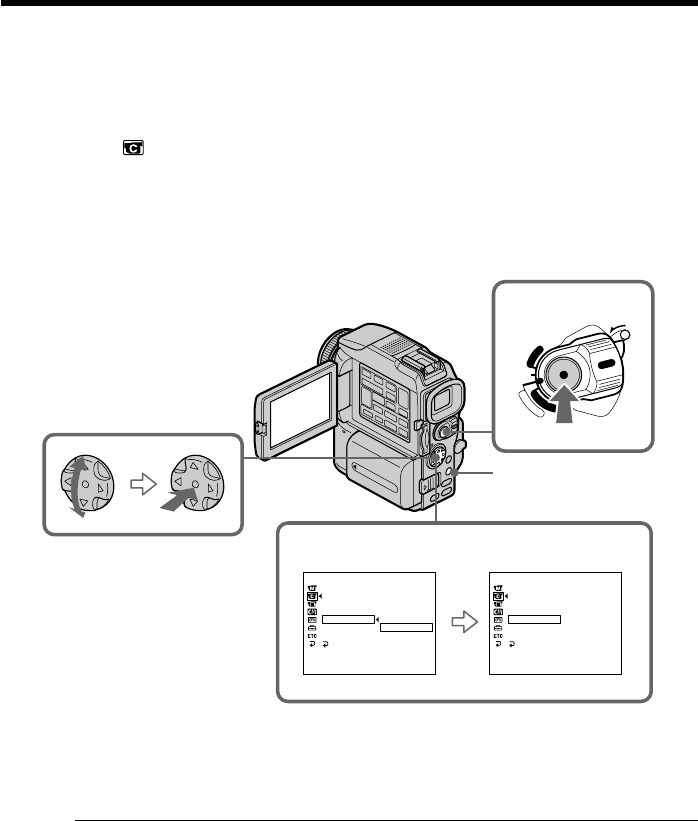
56
You can make a recording with a stop-motion animated effect using cut recording. To
create this effect, alternately move the subject a little and make a cut recording. We
recommend that you use a tripod, and operate the camcorder using the Remote
Commander after step 4.
(1)In the standby mode, press MENU, then select and decide upon FRAME REC
in with the control button (p. xx).
(2)Select and decide upon ON with the control button.
(3)Press MENU to erase the menu display.
The FRAME REC indicator lights up.
(4)Press START/STOP to start cut recording. The camcorder makes a recording
for about six frames, and returns to recording standby.
(5)Move the subject, and repeat step 4.
To cancel the cut recording
Perform either of the following:
–Set FRAME REC to OFF in the menu settings.
–Set the POWER switch to other than CAMERA.
Note
The proper remaining tape time is not indicated if you use this function continuously.
When using the cut recording function
The last recorded cut is longer than other cuts.
Frame by frame recording – Cut recording
4
2
LOCK
POWER
V
C
R
M
E
M
O
R
Y
C
A
M
E
R
A
OFF
(CHG)
CAMERA SET
D ZOOM
16 : 9W
I
DE
STEADYSHOT
N.
S.
L
I
GHT
FRAME REC
I
NT. REC
FLASH
LVL
RETURN
ON
[MENU] : END
CAMERA SET
D ZOOM
16 : 9W
I
DE
STEADYSHOT
N.
S.
L
I
GHT
FRAME REC
I
NT. REC
FLASH
LVL
RETURN
OFF
ON
[MENU] : END
MENU
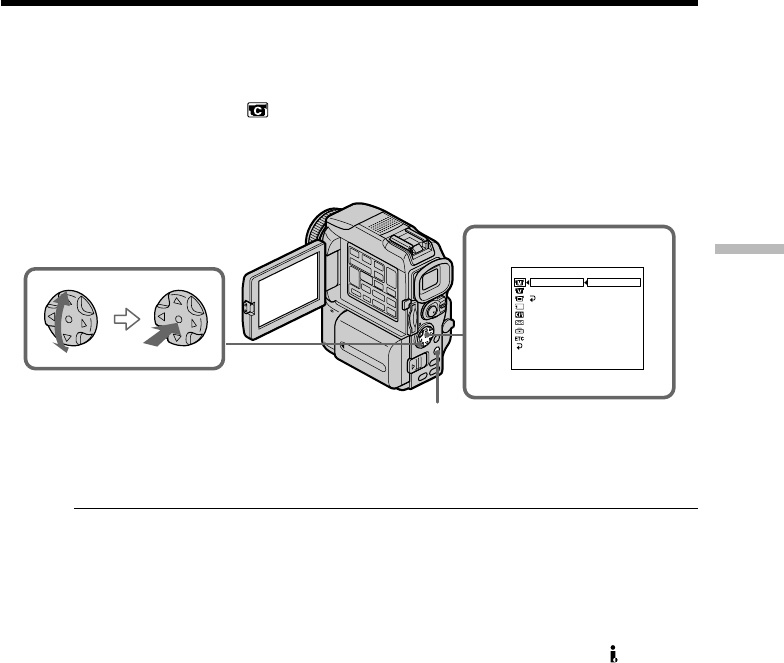
57
Advanced Playback Operations
During playback, you can process a scene using the picture effect functions: NEG. ART,
SEPIA, B&W and SOLARIZE.
(1)In the playback or playback pause mode, press MENU, then select and decide
upon P EFFECT in with the control button (p. xx).
(2)Select and decide upon the desired mode with the control button.
For details of each picture effect function, see page xx.
To cancel the picture effect function
Set P EFFECT to OFF in the menu settings.
Notes
•You cannot process externally input scenes using the picture effect function.
•You cannot record images on a tape on your camcorder when you have processed the
image using the picture effect function. However, you can record images on a
“Memory Stick” (p. xxx, xxx), or on a VCR using your camcorder as a player.
Pictures processed by the picture effect function
Pictures processed by the picture effect function are not output through the DV jack.
When you set the POWER switch to OFF (CHG) or stop playing back
The picture effect function is automatically canceled.
— Advanced Playback Operations —
Playing back a tape with picture effects
MENU
1
MANUA L SE T
.
OFF
NEG ART
SEP I A
B&
W
SOL AR I ZE
PEFFECT
DRETURN
EFFECT
[
MENU
] :
END
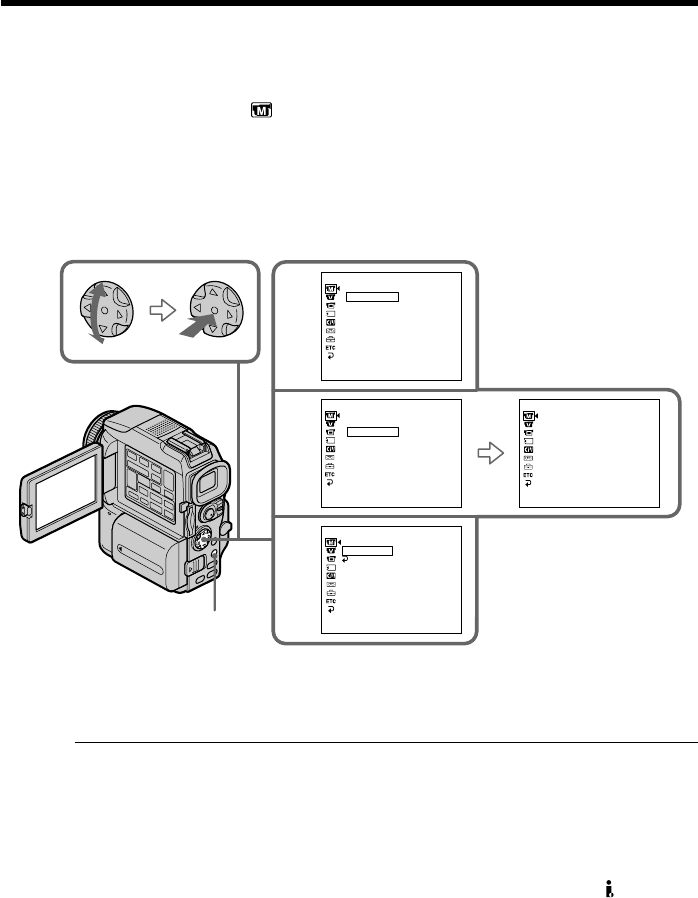
58
During playback, you can process a scene using the digital effect functions: STILL,
FLASH, LUMI. and TRAIL.
(1)In the playback or playback pause mode, press MENU, then select and decide
upon D EFFECT in with the control button (p. xx).
(2)Select and decide upon the desired mode with the control button.
The bars appear. In the STILL or LUMI. mode, the picture is captured and is
stored in memory as a still image.
(3)Press b/B on the control button to adjust the effect with the control button.
For details of each digital effect function, see page xx.
To cancel the digital effect function
Set D EFFECT to OFF in the menu settings.
Notes
•You cannot process externally input scenes using the digital effect function.
•You cannot record images on a tape on your camcorder when you have processed the
image using the digital effect function. However, you can record images on a
“Memory Stick” (p. xxx, xxx), or on a VCR using your camcorder as a player.
Pictures processed by the digital effect function
Pictures processed by the digital effect function are not output through the DV jack.
When you set the POWER switch to OFF (CHG) or stop playing back
The digital effect function is automatically canceled.
Playing back a tape with digital effects
1
2
3
MANUA L SET
OFF
ST I LL
FLASH
TRA I L
DEFFECT
[
MENU
] :
END
LUMI
.
MANUA L
[
MENU
] :
END
ST I LL
IIIIIIII
••••••••
RETURN
MANUA L SET
OFF
ST I LL
FLASH
TRA I L
DEFFECT
[
MENU
] :
END
LUMI
.
MANUA L SET
DEFFECT
[
MENU
] :
END
ST I LL
IIIIIIIIIIIIIIII
PEFFECT
DEFFECT
MENU
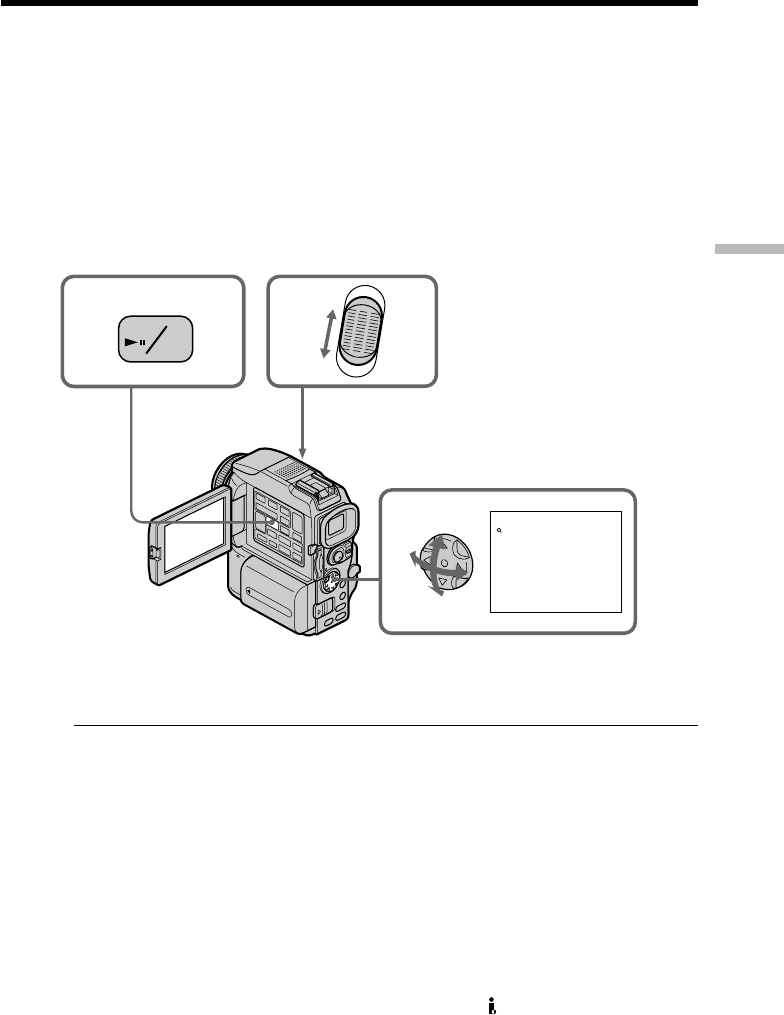
59
Advanced Playback Operations
You can enlarge playback images recorded on tapes. Besides the operation described
here, your camcorder can enlarge still images recorded on “Memory Stick”s (p. xxx).
(1)In the playback or playback pause mode, press PB ZOOM on your camcorder.
The center of the image is enlarged to twice its size.
(2)Press the control button to move the image.
The image moves in the same direction as the control button setting.
(3)Adjust the zoom ratio by the power zoom lever.
You can enlarge the image from 1.1 times up to five times its size.
W: Decreases the zoom ratio.
T: Increases the zoom ratio.
To cancel the PB ZOOM function
Press PB ZOOM.
Notes
•You cannot process externally input scenes using the PB ZOOM function with your
camcorder.
•You cannot record images on a tape on your camcorder when you have processed the
image using the tape PB ZOOM function. However, you can record images on a
“Memory Stick” (p. xxx, xxx), or on a VCR using your camcorder as a player.
The PB ZOOM function is automatically canceled when you operate the following
functions:
–Set the POWER switch to OFF (CHG).
– Stop playback.
– Display the menu settings.
Images in the PB ZOOM
Images in the PB ZOOM mode are not output through the DV jack.
Enlarging images recorded on tapes
– Tape PB ZOOM
2
PB ZOOM
× 5.0
1
MPEG PB
ZOOM
3W
T
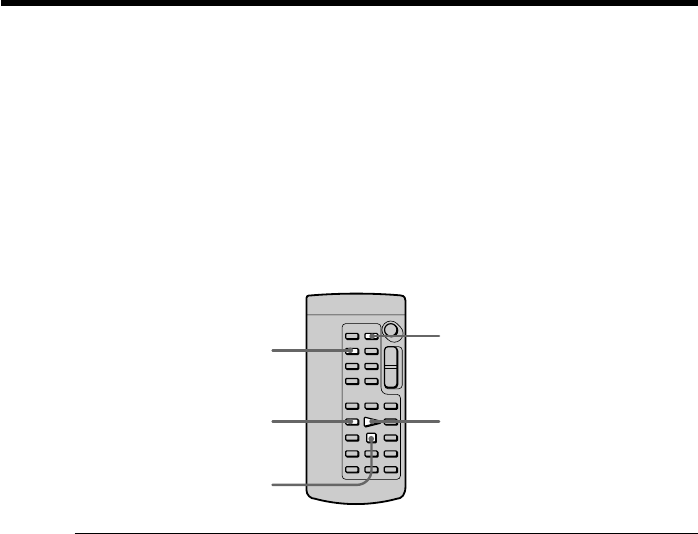
60
Your camcorder goes forward or backward to automatically stop at a desired scene
having a tape counter value of “0:00:00”. Use the Remote Commander for this
operation.
(1)In the playback mode, press DISPLAY.
(2)Press ZERO SET MEMORY at the point you want to locate later. The tape
counter shows “0:00:00” and the ZERO SET MEMORY indicator flashes.
(3)Press x when you want to stop playback.
(4)Press m to rewind the tape to the tape counter’s zero point. The tape stops
automatically when the tape counter reaches approximately zero. The ZERO
SET MEMORY indicator disappears and the time code appears.
(5)Press N. Playback starts from the counter’s zero point.
Notes
•When you press ZERO SET MEMORY before rewinding the tape, the zero set memory
function will be canceled.
•There may be a discrepancy of several seconds from the time code.
If a tape has a blank portion in the recorded portions
The zero set memory function may not work correctly.
Quickly locating a scene using the zero
set memory function
ZERO SET MEMORY
DISPLAY
m
x
N
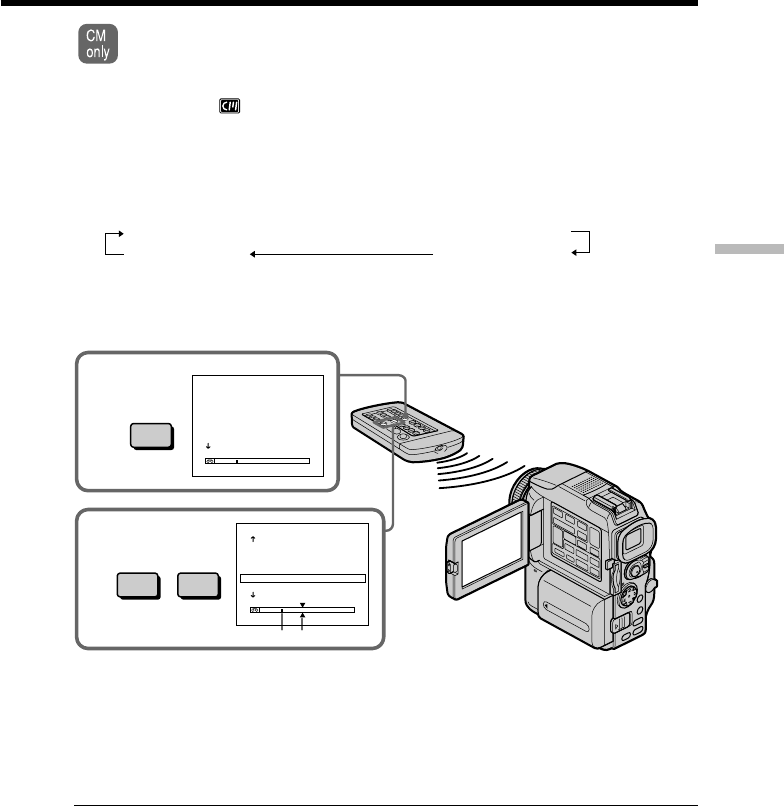
61
Advanced Playback Operations
If you use a tape with cassette memory, you can search for the boundaries of
recorded tape by title. Use the Remote Commander for this operation.
Before operation
Set CM SEARCH in to ON in the menu settings (p. xx). (The default setting is ON.)
(1)Set the POWER switch to VCR.
(2)Press SEARCH MODE on the Remote Commander repeatedly, until the TITLE
SEARCH indicator appears.
The indicator changes as follows:
TITLE SEARCH t DATE SEARCH t PHOTO SEARCH
no indicator TPHOTO SCAN
(3)Press . or > on the Remote Commander to select the title for playback.
Your camcorder automatically starts playback of the scene having the title that
you selected.
[a]Actual point you are trying to search for
[b]Present point on the tape
To stop searching
Press x.
If you use a tape without cassette memory
You cannot superimpose or search a title.
If a tape has a blank portion between recorded portions
The title search function may not work correctly.
To superimpose a title
See page xx.
Searching the boundaries of recorded
tape by title – Title search
3
.>
2
SEARCH
MODE
TITLE SEARCH
1
HELLO
!
2
CONGRA TUL AT I ONS
!
3
HAPPY NE
W
YEAR
!
4
PRESENT
5
GOOD
M
ORN I NG
6
W
EDD I NG
[b][a]
HCRAESELTIT
3
HAPPY NE
W
YEAR
!
4
PRESENT
5
GOOD
M
ORN I NG
6
W
EDD I NG
7
NIGHT
8
BASEBAL L
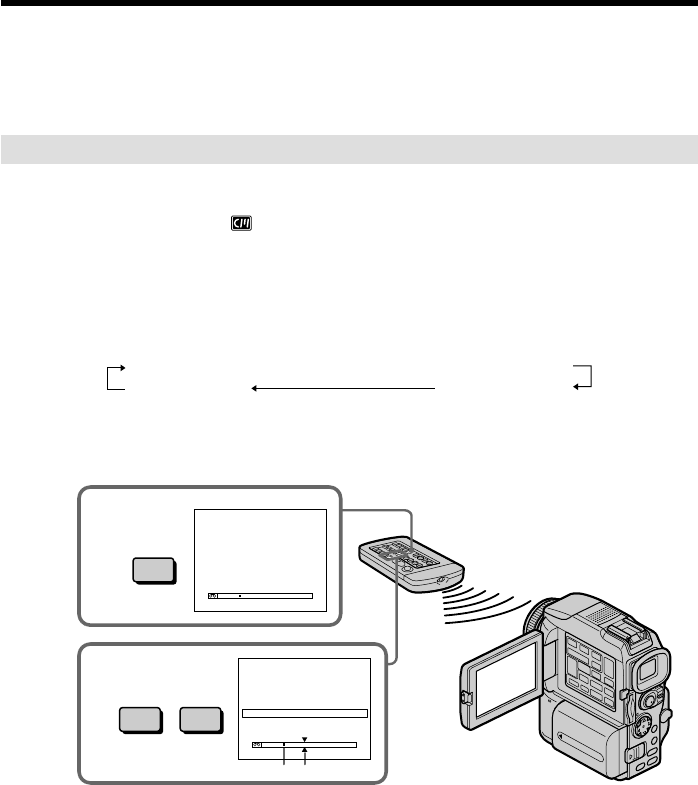
62
You can automatically search for the point where the recording date changes and start
playback from that point (Date search). Use a tape with cassette memory for
convenience. Use the Remote Commander for this operation.
Use this function to check where recording dates change or to edit the tape at each
recording date.
Searching for the date by using cassette memory
Before operation
•You can use this function only when playing back a tape with cassette memory.
•Set CM SEARCH in to ON in the menu settings (p. xx). (The default setting is
ON).
(1)Set the POWER switch to VCR.
(2)Press SEARCH MODE on the Remote Commander repeatedly, until the DATE
SEARCH indicator appears.
The indicator changes as follows:
TITLE SEARCH t DATE SEARCH t PHOTO SEARCH
no indicator TPHOTO SCAN
(3)Press . or > on the Remote Commander to select the date for playback.
Your camcorder automatically starts playback at the beginning of the selected
date.
[a]Actual point you are trying to search for
[b]Present point on the tape
To stop searching
Press x.
Searching a recording by date
– Date search
3
.>
2
SEARCH
MODE
DATE SEARCH
1
SEP
/5/01
2
SEP
/6/01
3
DEC
/24/01
4
JAN
/1/02
5
FEB
/11/02
6
APR
/29/02
[b][a]
DATE SEARCH
1
SEP
/5/01
2
SEP
/6/01
3
DEC
/24/01
4
JAN
/1/02
5
FEB
/11/02
6
APR
/29/02
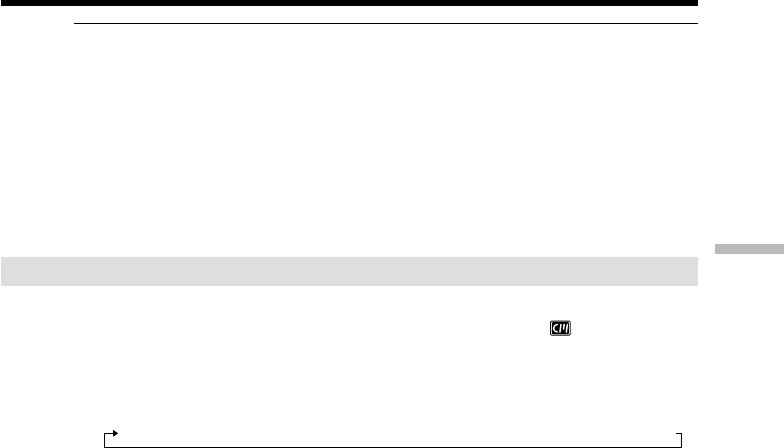
63
Advanced Playback Operations
Note
If one day’s recording is less than two minutes, your camcorder may not accurately find
the point where the recording date changes.
If a tape has a blank portion between recorded portions
The date search function may not work correctly.
Cassette memory
The tape cassette memory can hold six recording date data. If you search the date
among seven or more data, see “Searching for the date without using cassette memory”
below.
Searching for the date without using cassette memory
(1)Set the POWER switch to VCR.
(2)Press MENU, then select and decide upon CM SEARCH in to OFF with the
control button (p. xx).
(3)Press SEARCH MODE on the Remote Commander repeatedly until the DATE
SEARCH indicator appears.
The indicator changes as follows:
DATE SEARCH t PHOTO SEARCH t PHOTO SCAN t no indicator
(4)Press . on the Remote Commander to search for the previous date or press
> on the Remote Commander to search for the next date. Your camcorder
automatically starts playback at the point where the date changes. Each time
you press . or >, your camcorder searches for the previous or next date.
To stop searching
Press x.
Searching a recording by date – Date search
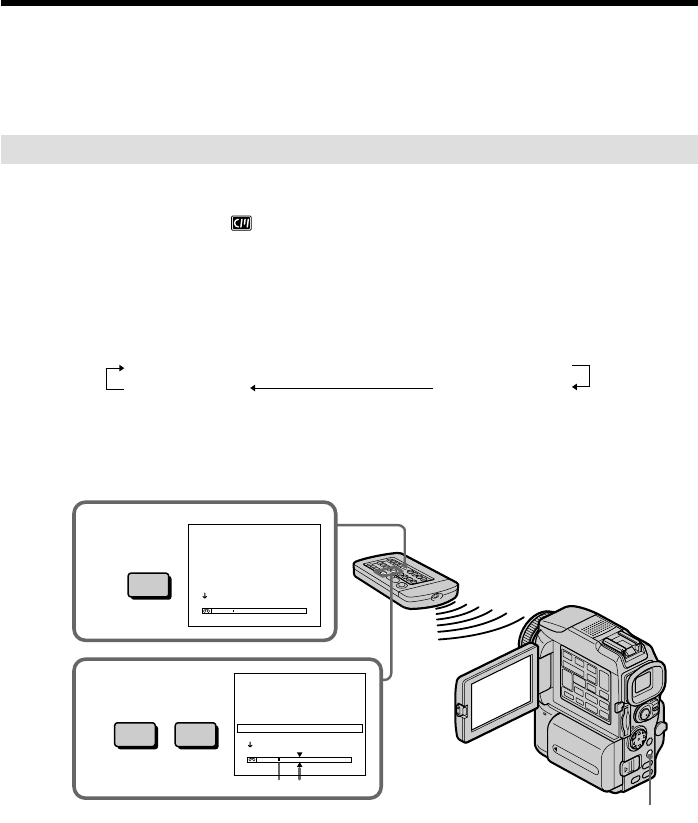
64
You can search for a still image you have recorded on a tape (photo search).
You can also search for still images one after another and display each image for
five seconds automatically regardless of cassette memory (photo scan). Use the Remote
Commander for these operations.
Use this function to check or edit still images.
Searching for a photo by using cassette memory
Before operation
•You can use this function only when playing back a tape with cassette memory.
•Set CM SEARCH in to ON in the menu settings (p. xx). (The default setting is
ON.)
(1)Set the POWER switch to VCR.
(2)Press SEARCH MODE on the Remote Commander repeatedly, until the
PHOTO SEARCH indicator appears.
The indicator changes as follows:
TITLE SEARCH t DATE SEARCH t PHOTO SEARCH
no indicator TPHOTO SCAN
(3)Press . or > on the Remote Commander to select the date for playback.
Your camcorder automatically starts playback of the photo having the date
that you selected.
[a]Actual point you are trying to search for
[b]Present point on the tape
To stop searching
Press x.
Searching for a photo
– Photo search/Photo scan
3.>
2SEARCH
MODE
PHOTO SEARCH
1
SEP
/ 5/01 5:30
P
M
2
SEP
/ 6/01 8:50
A
M
3
DEC
/24/01 10:30
A
M
4
JAN
/ 1/02 11:25
P
M
5
FEB
/11/02 4:11
P
M
6
APR
/29/02 1:45
P
M
[b][a]
PHOTO SEARCH
1
SEP
/5/0117:30
2
SEP
/6/01 8:50
3
DEC
/24 /01 10 : 30
4
JAN
/1/0223:25
5
FEB
/11 /02 16 : 11
6
APR
/29 /02 13 : 45
MENU
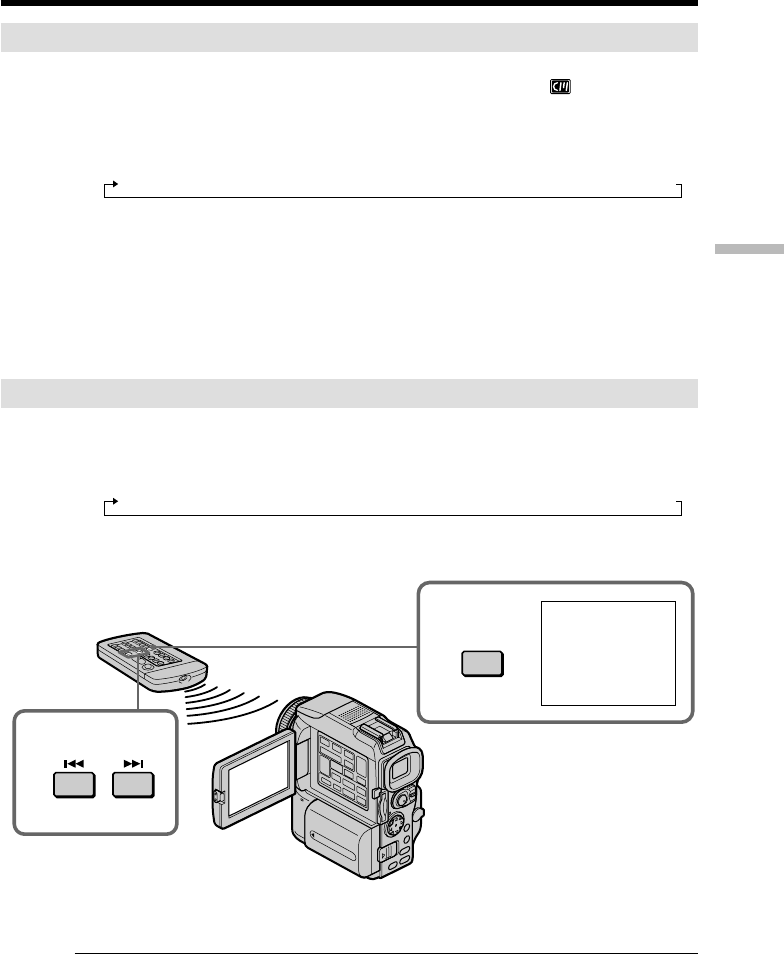
65
Advanced Playback Operations
Searching for a photo without using cassette memory
(1)Set the POWER switch to VCR.
(2)Press MENU, then select and decide upon CM SEARCH in to OFF with the
control button (p. xx).
(3)Press SEARCH MODE on the Remote Commander repeatedly until the
PHOTO SEARCH indicator appears.
The indicator changes as follows:
DATE SEARCH t PHOTO SEARCH t PHOTO SCAN t no indicator
(4)Press . or > on the Remote Commander to select the photo for playback.
Each time you press . or >, your camcorder searches for the previous or
next photo.
Your camcorder automatically starts playback of the photo.
To stop searching
Press x.
Scanning photo
(1)Set the POWER switch to VCR.
(2)Press SEARCH MODE on the Remote Commander repeatedly until the
PHOTO SCAN indicator appears.
The indicator changes as follows:
DATE SEARCH t PHOTO SEARCH t PHOTO SCAN t no indicator
(3)Press . or > on the Remote Commander.
Each photo is played back for about five seconds automatically.
To stop scanning
Press x.
If a tape has a blank portion between recorded portions
The photo search/photo scan function may not work correctly.
The available number of photos that can be searched using the cassette memory
The available number is up to 12 photos. However, you can search 13 photos or more
using the scanning photo function.
Searching for a photo – Photo search/Photo scan
SEARCH
MODE
SCAN
PHOTO
00
3
2